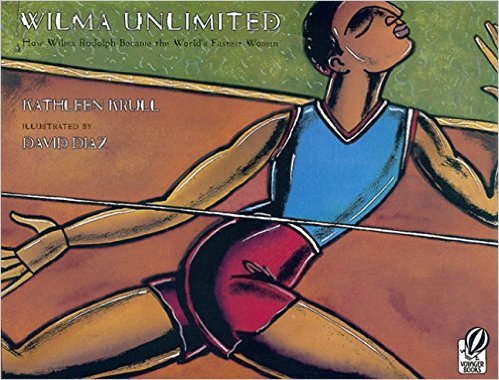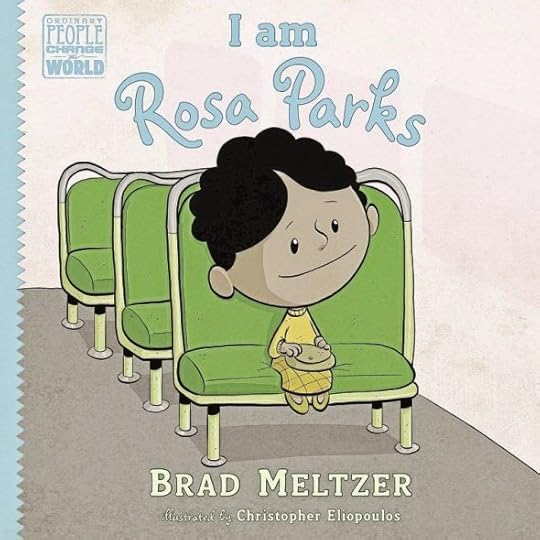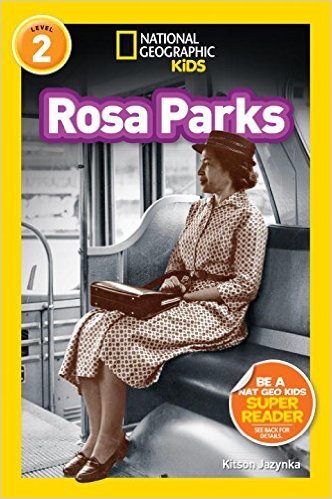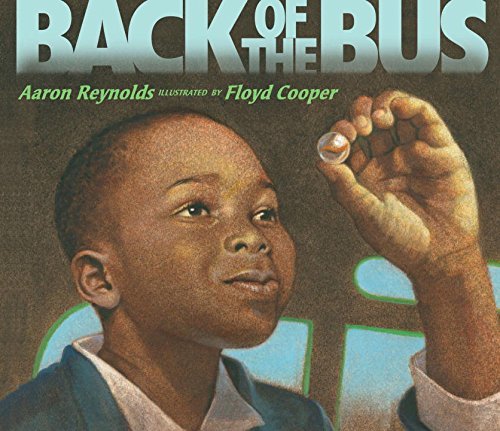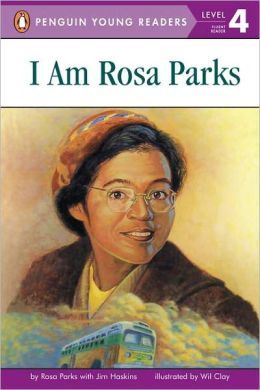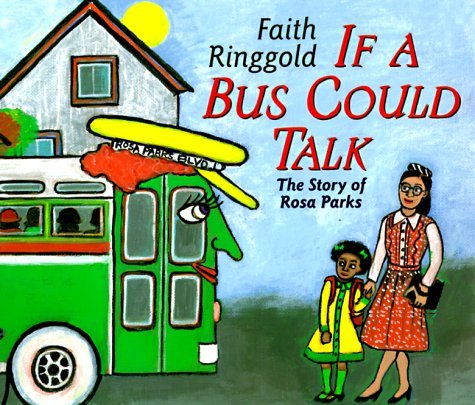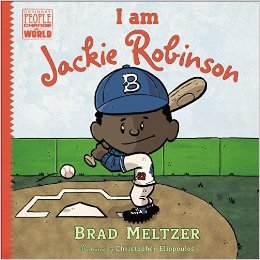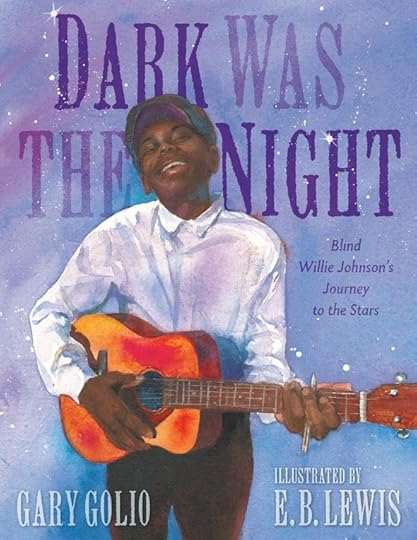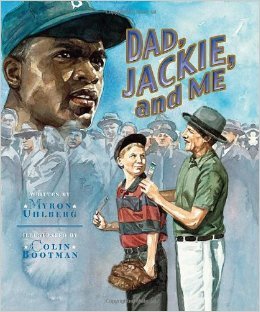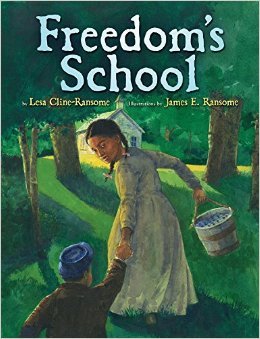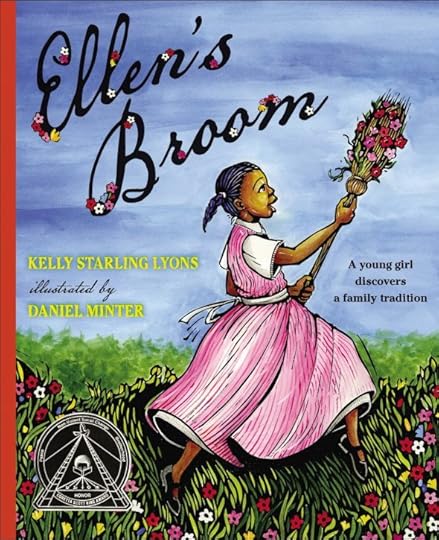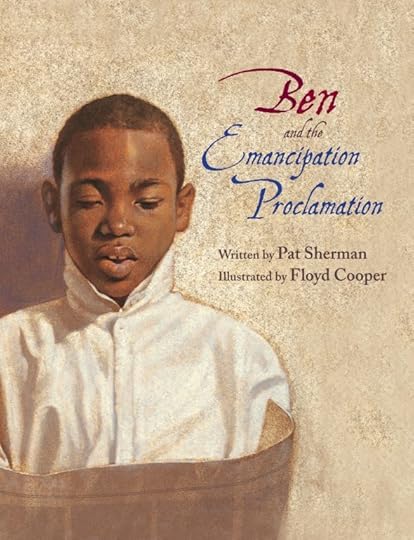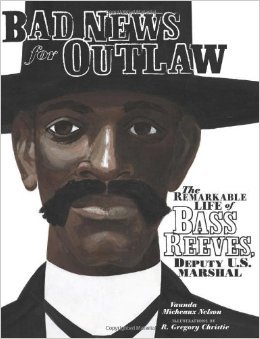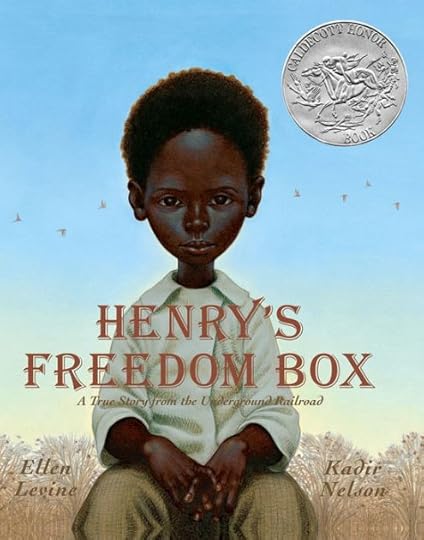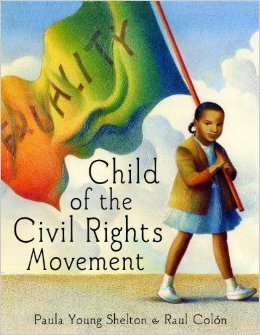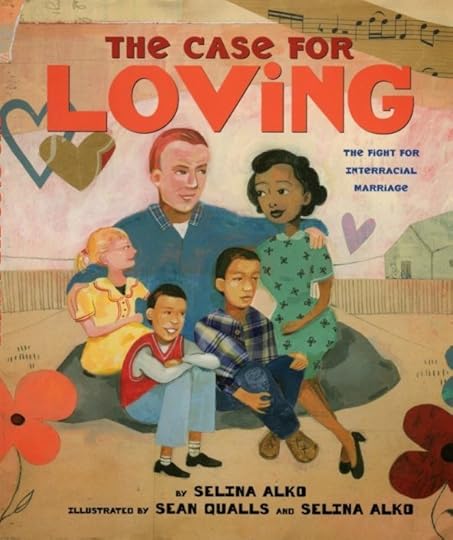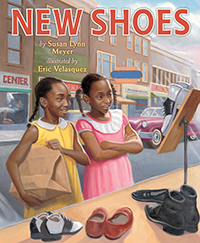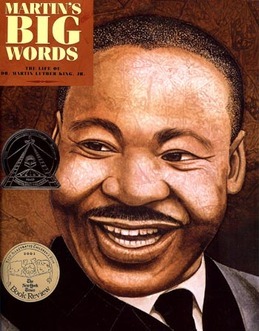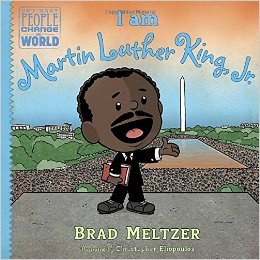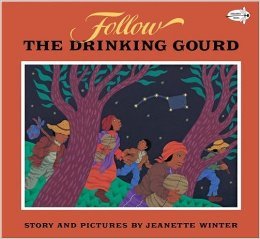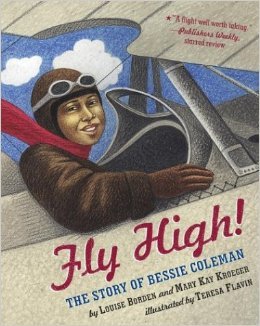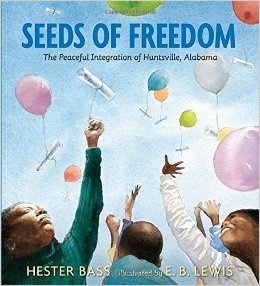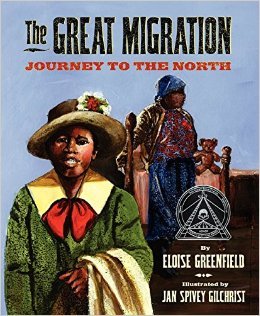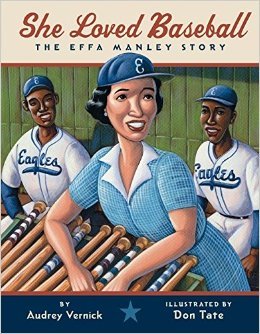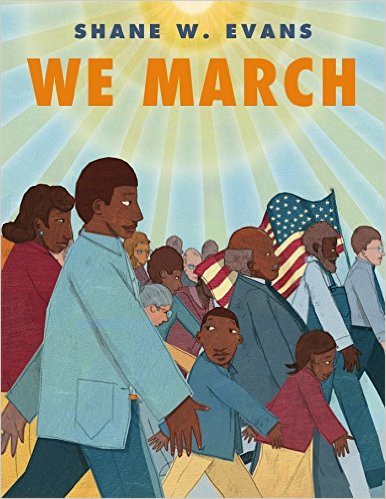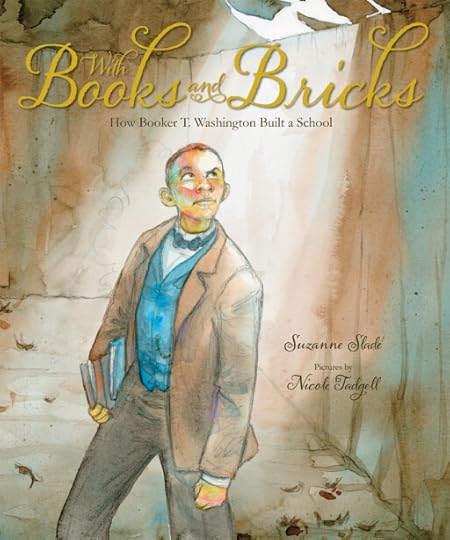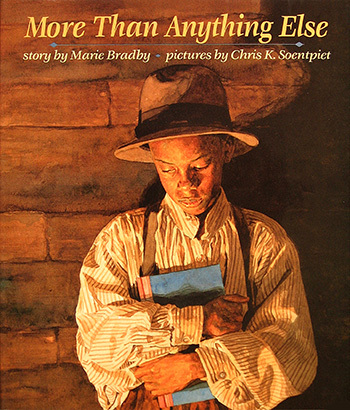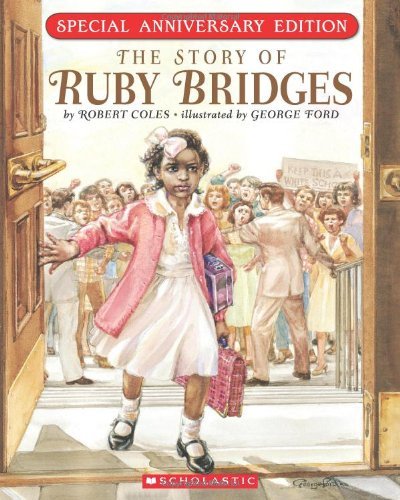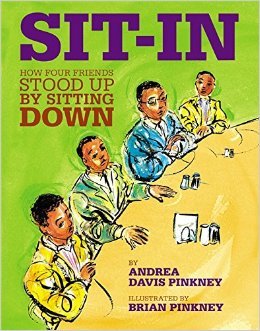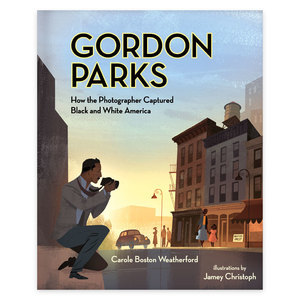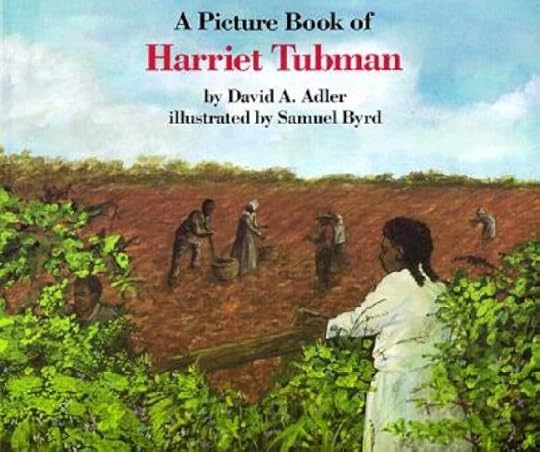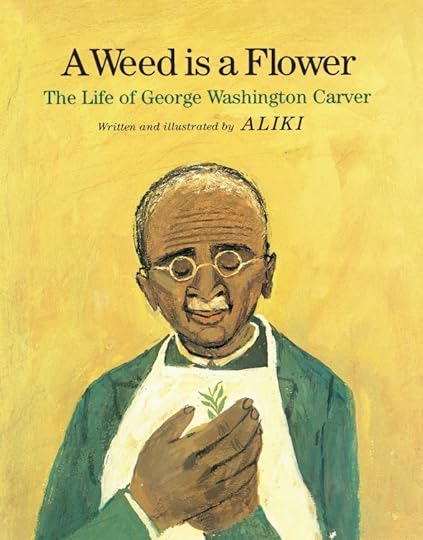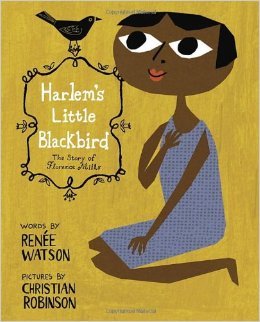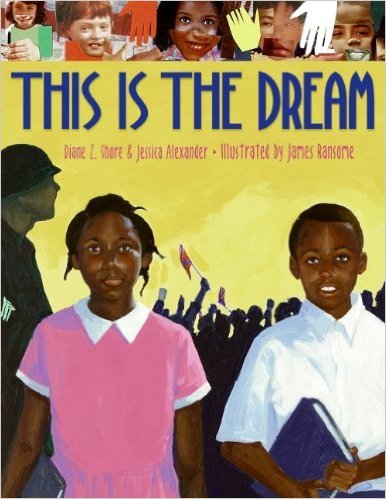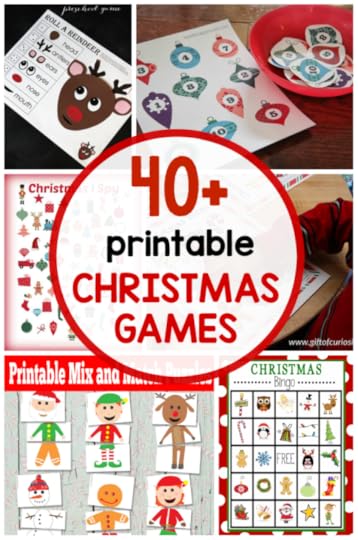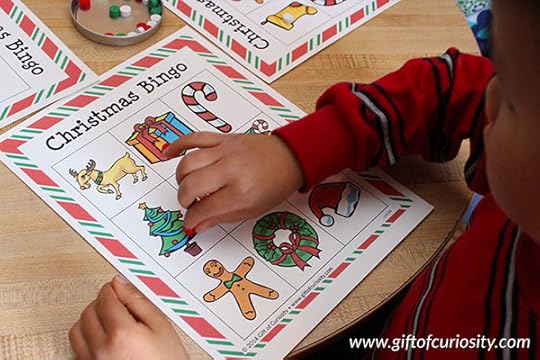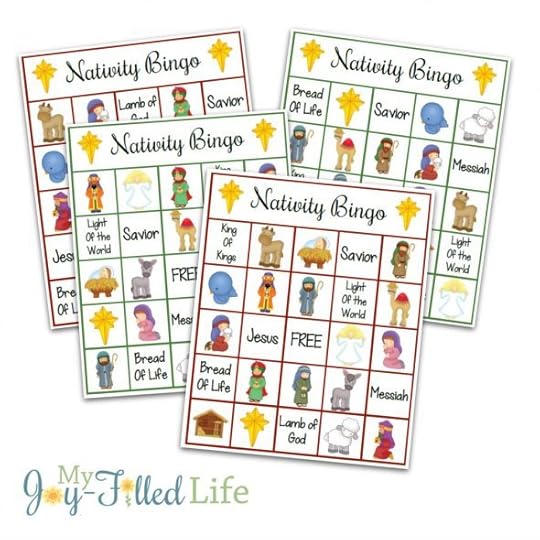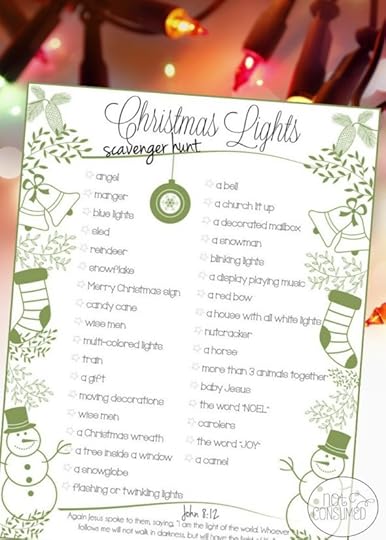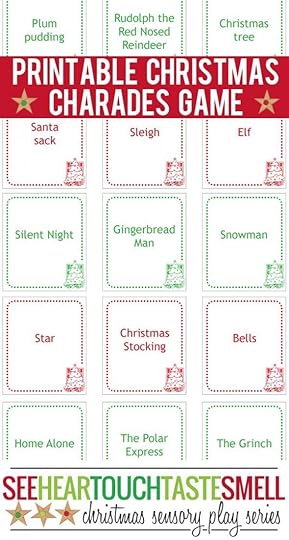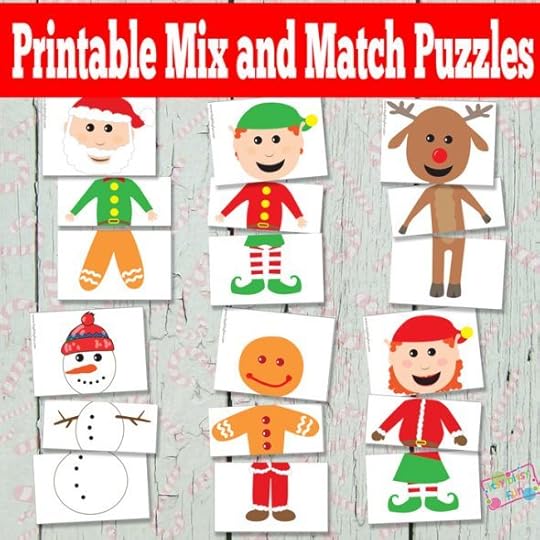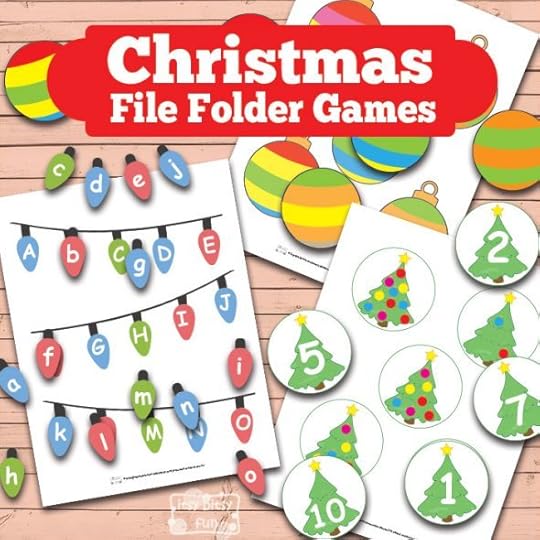Anna Geiger's Blog, page 29
February 8, 2021
Introduction to the science of reading podcast series

I’ve been poring over the science of reading research, and I’m making shifts in how I��approach teaching reading. You’re invited to join me on this exciting journey!
Listen to the episode hereFull episode transcriptTranscript
Download
New Tab
Well, hello! If you are watching with me on Facebook, you are seeing the video recording of Episode 34 of the Triple R Teaching podcast, where we help educators reflect, refine, and recharge so they're excited for the next day in the classroom. My name is Anna Geiger and I am your host. You may know me from my website, The Measured Mom, as well as my online courses, and my membership site.
Today, I want to start the podcast by telling you a little bit of a story. A few months ago, I had joined a Facebook group to learn more about teaching reading. It was actually a science of reading Facebook group. After spending a half an hour in the group, reading through comments, reading discussions, checking out resources, I was starting to feel not so good. I was getting sort of a tightness in my chest. I was starting to feel scared, my stomach hurt, and I had to get out of that group because it was starting to bring up a whole bunch of feelings in me that just didn't feel good. I actually opened Slack, which is a communication tool I use for my team, and this is what I wrote, "I just need to talk to someone. I am so scared. I've been doing a lot of research about the science of reading and it's completely overwhelming. It feels like everything I believed in is wrong, but it worked for so many kids and it worked for my own kids. Can't be 100% wrong, right? Now I feel like I have to completely rethink everything. I'm so confused. Please. I'm really worried and upset inside. I know this sounds over the top, but I feel so much responsibility to get this right!"
The fact is that what I had read in the group was concerning to me. There was a lot of heated discussion back and forth. There was a lot of judgment. There were a lot of big discussions, a lot of black and white thinking, it HAS to be THIS way! It scared me, and so I had to be careful about how often I was in the group so that it wasn't causing this visceral reaction inside of me. I needed to slowly get used to the group.
Now it's a couple of months later and I actually go there multiple times a day and love the things that I'm learning. But when we first hear something that feels different than what we've thought in the past, it can feel scary! It's true that a lot of what I was reading in there did not align with the things I learned in undergrad, graduate school, and the things that I've taught teachers to do.
Here's the good news though! What I've learned over the last few months- everything I believed and taught is NOT wrong! Even if you're in a shift in your teaching, the same is true for you. It's not completely black and white, but there are so many exciting things that we have to learn these days about how kids learn to read. Making shifts in the way that we teach can reach even more students, which at the end of the day is what we're all excited to do.
It has kind of felt like Christmas around here lately because I have been getting new professional books about teaching reading every day. So, if you can see, here's just one stack of books that I've gotten in the past few weeks. Then I'll move my chair, and now you can see behind me a whole stack of books and all that paper. The first couple inches of that are papers that I've printed from online journals so I can study more about how our brains learn to read and what implications that has for how we teach reading in the classroom. I'm looking particularly at kindergarten, first, and second grade.
So yes, I was really scared at first and really doubting myself. But the more I studied, the more I realized that there are so many wonderful things we were doing and so many more wonderful things we can do as we make shifts in our thinking and our practice!
This episode is actually launching a series on the podcast all about the science of reading, in particular, how it relates to how we teach reading in kindergarten, first, and second grade. I am so excited to be doing this series with you!
I recently sent an email out to my newsletter list and I told my people that in college I had an all nighter once. I stayed up all night so I could study for a really hard test, and I had two papers the next day. It was a failure. I did not get a happy grade in the test, even though I thought I was well prepared, because I needed a lot more sleep. Ever since then, I don't do all nighters, but I still love studying and researching.
This is just such a great time to be learning about teaching reading because lots and lots of stuff is becoming available to us. Just in the last couple of years a lot of new books have been written about the science of reading and the implications that it has for our classrooms. I cannot wait to start sharing that information with you.
Here's a little bit of a glimpse of what's coming. We're going to be starting next week, talking about The Reading Wars in America, how those started in the 1800s and where we're at today and what that means for us. We're going to talk about some of the basics when it comes to the science of reading. If you've done any study in that at all, you've probably heard of things like the simple view of reading, orthographic mapping, and Scarborough's Reading Rope. We're going to talk about all those things, but in a really simple, easy to access way. We're going to talk about phonics and the primary role, the BIG role this has, and why it's always the front seat of all of these discussions. It's certainly not all that the science of reading is about, but it's a big deal! We're going to talk about how to teach phonics, ideas for making it interesting in your classroom, and what kind of books our students should be using as we teach them to read. We'll review phonological and phonemic awareness a little bit, but as you know, we've already been doing that on the podcast for the last few weeks. We're going to talk also about comprehension, vocabulary, fluency, and we're going to get really practical about what all of this means for how you teach every day.
So not only have I been reading a lot of books and papers, but I've also had a lot of conversations. In the evenings after my kids went to bed, I've talked to a reading psychologist, a school principal, a few reading specialists, some classroom teachers, and I have more conversations scheduled. This has been a really exciting time for me to learn more about how we can improve how we teach to reach even more kids, and I hope that you're going to join me for the ride!
Starting next week, we'll be here again with the first episode in our series, "All About the Science of Reading".
I want to let you know one more thing before I go. And that is, I've got a survey that I would love to invite you to take. Particularly if you teach any kids in kindergarten, first, or second grade. You can find the survey at themeasuredmom.com/readingsurvey. You can tell me what questions you have about the science of reading, or what challenges you're facing right now as you teach reading so we can address some of those things in this series. Thanks again for joining me and I look forward to seeing you next week here on Triple R Teaching.
Scroll back to top
Sign up to receive email updates
Enter your name and email address below and I'll send you periodic updates about the podcast.
powered by
Link to original Facebook Live presentationVideo presentation
The post Introduction to the science of reading podcast series appeared first on The Measured Mom.
February 7, 2021
Books about black history
Today I’m sharing a huge list of our favorite black history books for kids!
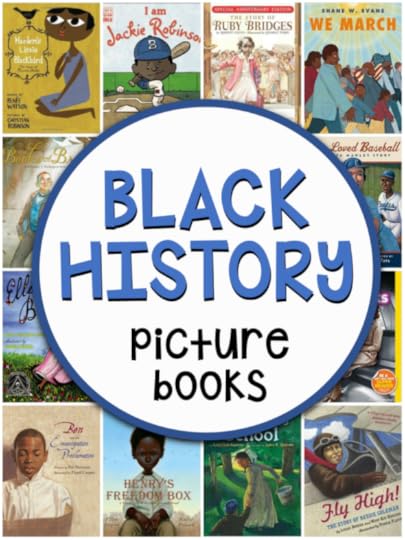
D o your kids encounter a lot of racial diversity?��
We live near a major American city, full of people of all races. But our own little suburb is mostly white. Unless we go shopping, my children don’t encounter a lot of faces different from their��own during the school week.
I can’t begin to understand the racial struggles that African Americans have faced throughout our history and in the present day. Neither can my children.
But we can try.
Over the past month, my first, second, and fourth grader have listened to countless books about notable African Americans.
We’ve been saddened by stories of��the slavery era, inspired by stories��of the civil rights movement, and stunned by��stories of incredible people��of whom we’d never heard.
Since 1975, Americans have recognized February as Black History Month.
During this month we make a special effort to recognize the often neglected accomplishments of notable African Americans.
Of course, we should be remembering the achievements of people of all races all year long.
Let this be a list you refer to every month of the year!
Black history books for kids
Wilma Unlimited, by Kathleen Krull
I start with this book because you must find it at your library! It’s the story of Wilma Rudolph, born tiny and sickly as the twentieth child to a poor, hard-working family. When Wilma suffered polio and paralysis at age five, everyone said she’d never walk again. ��No one guessed that she’d win three gold medals at the 1960 Olympics, becoming the fastest woman in the world!
My Five requested this book again and again.��I was happy to oblige!
I Am Rosa Parks, by Brad Meltzer
By refusing to give up her seat, Rosa Parks��became a leader in the long fight to end public bus segregation. This is her story.
With his Ordinary People Change the World series, Meltzer has created a fantastic set of picture book biographies. The stories��are told in a conversational style and feature engaging illustrations. Even my preschooler asks for them. I recommend that you reserve all of Meltzer’s books from your library now, before you forget!
Rosa Parks, by Kiton Jazynka
This little book is a gem from National Geographic Kids. I love the bright text, bold photographs, and interesting captions. I also love that it’s written in an easy-reader style at about a second grade reading level. Not only does it tell the inspiring story of Rosa Parks, but it also has a Cool Facts page, Quiz Whiz, and picture glossary.
Even my preschooler was engaged through the whole book.
Back of the Bus, by Aaraon Reynolds
This tells Rosa Parks’ story from a boy’s perspective. Sitting in the back of the bus with his mother, the boy has many questions and concerns when Mrs. Parks is arrested.��Children will relate to this captivating book.
I Am Rosa Parks, by Rosa Parks (with Jim Haskins)
Here’s another��book about Rosa Parks, told by the woman herself. My first grader loved this easy reader about the famous civil rights heroine.
If A Bus Could Talk, by Faith Ringgold
I love this book, but I want to offer a caveat – despite the cute picture and title, this book is for advanced listeners. It is a very long (and wordy!) biographical account of Rosa Parks. If your students know a little about her already and are up for a long read aloud, I highly recommend it.
Teammates, by Peter Golenbock
This book tells the true story of Jackie Robinson and Pee Wee Reese. ��Jackie was the first African American to play Major League baseball. This incredible��man faced threats and opposition at every turn while keeping his promise to “turn the other cheek.”
Pee Wee was the white player who had the courage to publicly support and befriend Jackie Robinson. ��My big kids (ages 6, 8, and 9) were fascinated by the story.
I Am Jackie Robinson, by Brad Meltzer
While grabbing a link on Amazon, I was surprised to read a scathing review of this book from the School Library Journal. The reviewer called it “preachy and moralistic” with a “perky tone that will cause eye-rolling among readers and listeners.”
I couldn’t disagree more! This wonderfully written and illustrated book is a gentle introduction to race issues and teaches the importance of leading by example.��In fact, after reading��this book on their own, my older kids were eager to read other books about Robinson.
Even my preschooler loved it and asked for it repeatedly.
Dark Was the Night: Blind Willie Johnson’s Journey to the Stars, by Gary Golio
This is a beautiful new book that the author recently shared with me, and it certainly deserves a place on this list! Willie Johnson was born in 1897, and at a young age he lost both his mother and his sight. Yet Willie made a way and a name for himself by singing on street corners. Years after his death, his song “Dark Was the Night” was launched into space on the Voyager 1��space probe’s Golden Record.
The beautiful watercolor illustrations are breathtaking, and I love the author’s way of speaking directly to Willie. One to find!
Dad Jackie and Me, by Myron Uhlberg
Based on the author’s own life, this is the story of an extra special summer for a father and son. For the first time, Myron’s deaf father shows an interest in professional baseball. Inspired by Jackie Robinson’s fight against prejudice, he keeps a scrapbook and asks his son to teach him how to catch a baseball. At the end of the book he has big news for his son: they are going to Ebbets Field to see Jackie play.
In the epilogue we learn that, as a deaf man, Myron’s father related to Jackie’s stoic endurance of prejudice and fight for acceptance.
Freedom’s School, by Lesa Cline-Ransome
This historical fiction picture book was another favorite. It’s the story of Lizzie and Paul, former slave children who finally have the chance to attend a school just for them.
But even though Lizzie and Paul are excited to finally go to school, it isn’t easy. The walk is long. The path is dangerous.��And when someone deliberately burns the school down, it seems like all hope is lost. But the determination of their teacher and other members of the community give this book a happy and hopeful ending.
Ellen’s Broom, by Kelly Starling Lyons
During the slavery era, slaves were not permitted to wed legally. Many of them literally “jumped the broom” when they made a commitment to live as husband and wife.
After slavery ended, former slaves could visit a local courthouse to become legally married. This book is the fictional account of Ellen and her family who visit the courthouse, broom in hand, to make her parents’ marriage legal.
A lovely story with beautiful illustrations!
Ben and the Emancipation Proclamation, by Pat Sherman
This is the true story of a slave named Benjamin Holmes who taught himself to read by studying street signs. Though Ben was a hard-working, valued slave, he was sent to a slave prison when his master joined the Confederate army. When the slaves smuggle in a newspaper, Ben has��the privilege of reading the Emancipation Proclamation to his fellow captives.
Bad News for Outlaw, by Vaunda Micheaux Nelson
One thing these books have taught me is that there are some amazing African American heroes whom I’ve never even heard of. Bass Reeves is one of them. Born into slavery, he later became a Deputy U.S. Marshall – and one of the most feared and respected lawmen in the territories. It’s a long book with a fair amount of unfamiliar vocabulary, which made it a great book to read and discuss with my big kids (ages 6, 8, and 9). They were riveted.
Henry’s Freedom Box, by Ellen Levine
This is the��astounding true story of Henry Brown, a hard-working American slave who deeply loved his wife and children. One day, while he was at work, Henry’s wife and children were sold. Heartbroken, Henry��decided to mail himself to freedom. After a 27-hour journey, cramped in a crate, Henry arrived safely in Philadelphia.
Tragically, Henry never saw��his family again. But he lived the rest of his life as a free man.
Child of the Civil Rights Movement, by Paula Young Shelton & Raul Colon
This is a fantastic book written by the youngest daughter of Andrew Young. She tells the story of her parents moving from their home in the North back to the segregated South – to become leaders in the Civil Rights Movement.
I��loved this rare, behind-the-scenes look at how Young, King, Abernathy, and other civil rights leaders planned and marched to Montgomery.
The Case for Loving, by Selina Alko
My kids were astounded that Richard and Mildred Loving’s marriage was illegal in the state of Virginia – simply because he was white and she was black. This book is the story of their battle to change the law… all the way to the Supreme Court.
New Shoes, by Susan Lynn Meyer
This is the fictional��story of two girls who live during the Jim Crow era. They are hurt and humiliated to learn that they’re not permitted to try on shoes in shoe stores simply because they are black. So they collect second hand shoes from their black neighbors and create their own shoe store, where everyone can try on shoes before buying them.
We loved��this book! It’s a thought-provoking story��with endearing��characters and beautiful illustrations.
Martin’s Big Words,��by Doreen Rappaport
With its collage style illustrations and very simple story line, this book is an excellent introduction to Martin Luther King, Jr. I love how it weaves his quotes throughout the story of the civil rights movement. An excellent book!
I Am Martin Luther King, Jr. by Brad Meltzer
In Meltzer’s signature style, he talks directly to children in this engaging first-person biography of Dr. Martin Luther King, Jr. Like all of Meltzer’s books, the illustrations are unique: King is illustrated as a miniature version of his adult self on every page, even as a young child. This may be confusing to preschoolers who wonder why a little boy has a mustache. If this bothers you, I think the book is good enough to look past it!
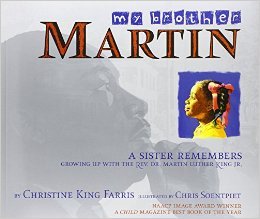
My Brother Martin, by Christine Farris
I highly recommend this beautifully-told memoir by��the sister of Martin Luther King, Jr. Young listeners will love the stories from King’s childhood and be inspired by his determination to speak out against hatred and racism.
Follow the Drinking Gourd, by Jeanette Winter, is the moving story of Peg Leg Joe, a conductor on the Underground Railroad who taught slaves the song “Follow the Drinking Gourd.” It sounded like a simple folk song, but within its lyrics were clues that led slaves along the path to freedom.
We don’t know whether Peg Leg Joe was a real person, but the story is ��a wonderful introduction to the Underground Railroad for young listeners.
Fly High! by Louise Borden and Mary Kay Kroeger
This is a long picture book that tells the story of Bessie Coleman, a determined woman who overcame both poverty and prejudice to become the first African American to earn a pilot’s license. Because of the length, I recommend this book for advanced listeners – but the text and pictures make it an enjoyable��listen.
Seeds of Freedom, by Hester Bass
We’re familiar with all the tragic stories of integration – from police dogs to bombings, but most of us haven’t heard of the peaceful integration��of Huntsville, Alabama. We loved this story of a small town whose members worked together to peacefully integrate their city and schools. ��Do note that this is a very long book. I recommend it for advanced listeners.
The Great Migration, by Eloise Greenfield
Through a collection of poems and collage artwork, this book tells the stories��of African Americans who left their homes in the South in the hope of a better life in the North. ��My kids loved the illustrations.
She Loved Baseball��, by Audrey Vernick
This is the remarkable story of a woman who owned an African American baseball team. Effa Manley not only cared for her players, she also stood up for the rights of African Americans everywhere. Later, when her players were integrated into the major leagues, she fought for their right to get fair salaries and to be recognized in the baseball hall of fame.
My only complaint about this book is that it had too much baseball talk. But that’s because��I love history, not sports. 
We March, by Shane W. Evans
If you’re looking for a short and simple book that will introduce the civil rights march to young readers, this is it. With just a couple of words on each page and bold illustrations, it will introduce young listeners to the March on Washington for Jobs and Freedom. Such a great conversation starter!
With Books and Bricks, by Suzanne Slade
This is my favorite book about Booker T. Washington, the former slave who became a teacher and built his own school for black students – the Tuskegee Institute. Like us, you’ll be stunned by this story of hard-working people who worked hour after hour to make thousands of bricks – by hand! This school with humble beginnings had a hundred buildings and fifteen hundred students at the time of Booker’s death.
Be sure to reserve this true story of one of America’s greatest educators. Highly recommended!
More than Anything Else, by Marie Bradby
If you’d like a book about Booker T. Washington’s life as a child, this is the one to get. We love this beautiful first-person narrative about the post-slavery era. ��Despite working all day at the saltworks, 9-year-old Booker is determined to learn to read and unlock the power of words. What a wonderful story!
The Story of Ruby Bridges, by Robert Coles
This is my favorite kid-friendly book about Ruby Bridges, the brave first grader from New Orleans who was the first black child to attend William Frantz Elementary. I like how this book emphasizes her Christian faith amidst the hate and prejudice that she endured.
Sit-In, by Andrea Davis Pinkney
The author tells the story of the four young black men who took a stand against segregation��by sitting down at the whites-only lunch counter in Woolworth’s. We enjoyed the poetic prose and cooking metaphors in this stunning portrait. For older listeners.
Gordon Parks, by Carole Boston Weatherford
Before Gordon Parks became the first black director in Hollywood, he was a poor African American looking for work. Armed with a camera, he began taking��stunning photographs in America’s cities. Parks’��photos of struggling African Americans helped illuminate racism and segregation, making him a strong advocate for the Civil Rights Movement.
Such an interesting book! Appropriate for young listeners.
A Picture Book of Harriet Tubman, by David Adler
We own this book, and it’s been a favorite of my kids for years. In fact, as preschoolers my older kids would run around the house playing “Harriet Tubman.” They were fascinated by this picture book biography of the famous former slave who led many African Americans to freedom on the Underground Railroad.
We have many of Adler’s books, and even my preschoolers enjoy them – despite their length.
If you like this book, you’ll also like other titles by Adler: A Picture Book of Rosa Parks, A Picture Book of Frederick Douglass, A Picture Book of Thurgood Marshall, A Picture Book of Dr. Martin Luther King, Jr., and A Picture book of Jackie Robinson.
A Weed is a Flower: The Life of George Washington Carver, by Aliki
Have you heard of the former slave who became a great scientist? This is a vintage book (1965), but my kids still enjoyed��the lovely illustrations, the interesting story, and the captivating text. Just be aware that you will probably want to substitute some of the language, as the book uses the word “Negro” to refer to African Americans.
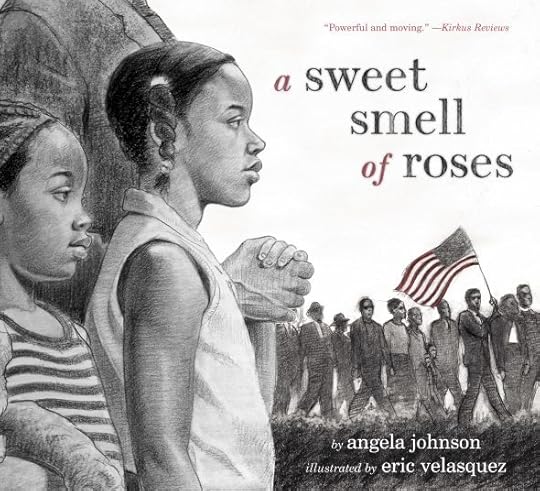
A Sweet Smell of Roses, by Angela Johnson
This gentle book honors the children who participated in the civil rights marches of the 1960’s. I love the powerful charcoal images in this thought-provoking story. Great for young listeners!
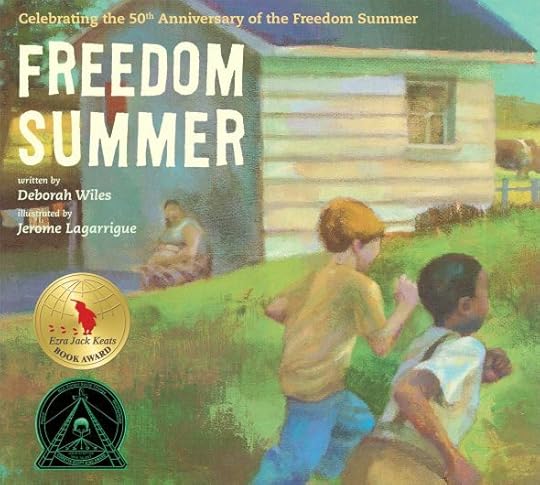
Freedom Summer, by Deborah Wiles
Joe and John Henry are good friends who are a lot alike. But the two friends can’t do everything together because Joe is white and John Henry is black – and much of their Southern town is closed off to��its black citizens.
When a law ��is passed that forbids segregation and opens the town pool to everyone, the boys eagerly race each other there… only to find that the city is filling it with asphalt rather than let blacks and whites swim together.
Despite this heartbreaking ending, the book is beautiful and inspiring ��– and one of my favorites! ��Recommended.
Harlem’s Little Blackbird, by Renee Watson
This is a beautiful��book about Florence Mills,��the daughter of former slaves who became a famous singer and dancer in the 1920’s. Like me, you will probably want to jump straight to Youtube to find a recording of her voice. Sadly, none exists, but you will treasure this story of a woman who used her fame and fortune to��advance civil rights.
This is the Dream, by Amistad
This lyrical rhyming book is a fantastic introduction to the civil rights movement. But it’s also a beautiful book that older listeners will enjoy. I absolutely love this treasure of a book which honors the people who brought about change through their peaceful protest.
We hope you enjoyed this list of amazing picture books!
Did we miss your favorite? Share in the comments!
MEMBERS GET PRINTABLE BOOK LISTS!
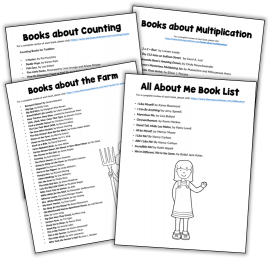
Members of The Measured Mom Plus get one-click access to each of our printable book lists … not to mention practical video workshops, no-print resources, and hundreds of printables. Not a member yet? Learn more here.
CHECK OUT ALL THE BOOK LISTS IN THE MEMBERSHIP
The post Books about black history appeared first on The Measured Mom.
January 31, 2021
5 Tips for teaching phonological awareness virtually
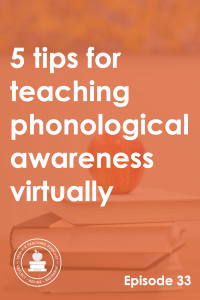
Virtual teaching hasn’t made things easy on us, but I have good news! You can easily teach phonological and phonemic awareness from a distance. These tips will help!
Listen to the episode hereRecommended ResourcesFree sample of phonological and phonemic awareness activitiesPhonological & Phonemic Awareness Super BundleHeggerty Phonemic Awareness CurriculumFree phonemic awareness curriculum from Reading Done RightEquipped for Reading Success, by David A. KilpatrickFull episode transcriptTranscript
Download
New Tab
Hello, my name is Anna Geiger, and thank you for joining me for this presentation on Facebook. I am The Measured Mom at themeasuredmom.com. I also have a membership site, The Measured Mom Plus, two online courses, "Teaching Every Reader" and "Teaching Every Writer", as well as Facebook groups, and a podcast, "Triple R Teaching". The podcast helps educators reflect on what they're doing, refine by making small doable changes, and recharge so they're excited for the next day in the classroom.
You are listening to Episode 33 of the podcast which is all about how to teach phonological and phonemic awareness VIRTUALLY.
We have been spending the last month diving deep into these important prereading skills, phonological and phonemic awareness. Let's take a quick review of the things that we've talked about in the past few weeks.
We talked about the difference between phonics, phonological awareness, and phonemic awareness. We talked about why phonemic awareness is so crucial for helping kids become strong readers, and the reason is because scientists are telling us that when kids read, they do a process called orthographic mapping. It's a mental process that strong readers have, and it has to do with connecting the phonemes to the graphemes. That means connecting the individual sounds to the individual letters in a word. If they don't have an ear for sounds, so they don't have phonological, or specifically phonemic awareness, orthographic mapping cannot take place and they won't be able to remember those words easily for the future. That's why we have spent so much time talking about this.
We talked about specific levels of phonological awareness, from the very basic, rhyming, all the way to the most advanced, which is phonemic awareness. Then we also talked about the levels of phonemic awareness itself, starting with the very basic skill of phoneme isolation, where you can hear individual sounds, all the way to manipulation, where you can add sounds to a word, delete sounds, and substitute.
After we learned all of this base knowledge, we moved on to talk about what you do with it! I gave you some recommendations for programs, and I also talked about the importance of mixing things up. So not only do you want to have a daily routine of about 10 minutes of teaching these skills, but you also want to do things like read aloud rhyming books and books with alliteration. You want to make sure that you mix it up with interesting things like games and perhaps dances, or anything that helps your students learn the skill in a different way and helps prevent boredom for all of you. Because as wonderful as those scripted programs can be, they can also begin feeling rather tedious after a while, so it's good to mix them up with some other things.
So now, today I want to talk to you about how to do this virtually. I'm going to give you five quick tips, so if you're short on time today, good news, this is not going to take long!
Much of the way that you teach phonological and phonemic awareness virtually is going to be the same way you would do it in the classroom, because this is an oral skill for the most part. So if you're using something like Heggerty or the free program at reallygreatreading.com, where you can print out the lessons, it's all comprised of you talking and your students responding. You can simply do that on the computer as well, but the only issue would be that you need to make sure that you've got a setup so that they can see you in real time and you can see them.
Now, in terms of programs to use, like I've mentioned many times, Heggerty is a really good one. They actually have virtual, prerecorded lessons, that you can purchase and use, but I think as much as possible, it's nice to do them live with your students.
My first tip is to make it a part of your daily routine. I would say preferably at the beginning, like a warmup, because it involves so much engagement on their part as you're talking to them, and they're responding to you back and forth constantly. It could be a really good way to kind of wake everybody up and start your virtual classroom day. Even in an in-person classroom, it could be a great way to start your day.
My next tip is to be consistent in your oral and visual cues. Again, Heggerty is really good at this. They supply a lot of hand motions and things that you can look into. I personally have not studied their hand motions, but for an example of something you could do, when you're giving a prompt, you can be pointing to your lips. Then when you want your students to respond, you could put your hand to your ear. So you could say, "I say cat, you say cat" (pointing to your lips), and then you listen (putting your hand to your ear). Then you might say something like, "Take the word cat, take the sound /c/ and change it to /b/". Then maybe you give them some wait time and maybe you point to your head while they're thinking, as you want them all to be thinking about it. Then you say, "Ready?", and then your hand to your ear means they respond to you.
That's just one example of how you might do it, amd I'm sure you can think of better ones! I'm sure Heggerty has a really good set of visual cues to use as your students are responding to you, so go ahead and check that out. I think that's really important, because as your students do those movements automatically, it frees up their brain to think about the more challenging things you're asking of them.
Something else you could do, this is from Heggerty's website, is to consider having all the students muted except for a few every day. The reason being is so you can really focus in on several students and hear how they're doing. You could create a calendar, and on it you list which students will be un-muted every day so that you make sure you hit everybody, and you have a chance to really listen in on how they're doing.
The next tip is to make sure that your camera is set up so that when you are giving your cues, they go in the correct direction. I know sometimes when we use cameras things can be flipped. If you've been doing virtual teaching for a while now, I'm guessing you're a pro at this and you know how to make sure that nothing is backwards. But just a good reminder to practice first and check and see what it looks like before doing this with your students.
So we've talked about making it a routine, being consistent with your oral and visual cues, muting some of your students, different ones every day, and then making sure your camera is set up properly.
The last tip has to do with things I've already talked about in this series, which is to mix things up! I think it's really good to do those oral lessons every day, but I think it's also good to mix it up, and especially to include something visual on your screen. I can only imagine how challenging it's been all these many months for some of you to be teaching virtually and to keep your students' attention. It is not easy! And so, putting something visual on the screen, something fun, can help break things up a bit.
For example, you could put a fun scene on your computer. You could grab it anywhere, there's a lot of picture of the day things you can find, but put a nice photograph on there and then give a clue. If you're teaching phoneme isolation, you could say, "Who can find something in the picture that starts with /c/?" Or if you're teaching phoneme blending, you could say, "I'm going to say a mystery word, find the answer in the picture. Here's the mystery word, /f/, /i/, /sh/. Who can blend those sounds and find the picture?" It's connecting those mental skills to something on the screen.
Then I would also ask you to consider looking into some kind of visual lessons that provide answers on the screen. So if you're wondering how that can work exactly with phonological awareness, I just created a set of 30 digital presentations and I'd love to share those with you really quick. If you're listening to this in the future on the podcast, you won't be able to see this, but you can always go to the show notes, themeasuredmom.com/episode 33, to get the link to the Facebook post where this video first was shown. You could also go ahead and check out the preview of this product in my shop.
Let me go ahead and switch my screen really quickly to show it to you. Once you purchase the digital lessons, you'll have access to 30 different lessons, and each one has anywhere from 20 to 40 slides. They start really basic here, and we've got some for every level. So let's say we're doing the rhyming one, "Do They Rhyme?" What you would do is open it up on your computer, and then for most of these, you would put it in present mode so the students can't see what's coming up. Then it also has a script for you if you want to follow it. On the first page it says, "Say the picture's names. Do the words rhyme?" Then the kids say "cat, hat". To check their answer, you move to the next slide, and yes, they do rhyme! So what you could have said on the first one is, put your thumb up if they rhyme, put your thumb down if they don't, and then they would check it when you move to the next slide.
They get more complex, of course, as we get to more challenging skills. For example, substituting syllables in compound words. What you would do is read the script, "Say doghouse, but change 'dog' to 'hen'." Once they've given the answer, you flip to the answer screen and there is the picture of the henhouse. This is a fun way to keep their attention and it's kind of self checking while you're doing the presentation. These are very simple, clean visuals with engaging pictures that will help you mix up and improve, in some ways, your phonological and phonemic awareness instruction by helping more kids stay engaged. We're always looking for ways to do that, whether we're teaching virtually or in the classroom!
If you want to purchase the whole set of phonological and phonemic awareness digital slides presentations, they will soon be in my shop for $18. However, if you're listening to this in real time (end of January/beginning of February 2021), then I have a special offer for you! You have the opportunity to purchase the entire Phonological and Phonemic Awareness Bundle, which is a big collection of printable activities and is normally $57, on sale for only $27 through February 8th. You will also get the digital slides presentations as a free bonus! These normally cost $18, but you can get all of it right now for $27.
If you go to themeasuredmom.com/offer, you will find this offer where you can get the whole bundle of Rhyming, Syllables, Phonemic Awareness, Nursery Rhyme Concepts of Print, and Personalized Emergent Readers. When you buy them separately, they're $89, but when you buy them in a bundle for the special offer, they're just $27. Plus you get the special offer of the digital lessons! This video here on the sales page will help you see more about the digital products because you can watch a bunch of them in action. Go ahead and check that out to make sure it's something that's going to work for you, and then you can just click down here to purchase.
After this timer runs out, this page will revert to a regular offer for the bundle. So if you're interested, now is the time, themeasuredmom.com/offer. My team and I are always here to answer questions, so if you need to reach out to us, you can reach us at hello@themeasuredmom.com.
That concludes Episode 33. For show notes, head to themeasuredmom.com/episode33.
Next week we'll be kicking off a new series, so stay tuned for that!
Scroll back to top
Sign up to receive email updates
Enter your name and email address below and I'll send you periodic updates about the podcast.
powered by
Link to original Facebook Live presentationVideo presentation
The post 5 Tips for teaching phonological awareness virtually appeared first on The Measured Mom.
January 24, 2021
Answers to common questions about teaching phonological and phonemic awareness
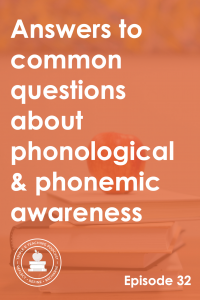
I��conducted a survey to find out the questions teachers have about phonological and phonemic awareness … and over 3000 educators responded!
In this episode we’ll tackle these questions:
Is there a chart or guide that shows us which skills to teach (and in what order)?At what age should we start … and how old should kids be when we stop teaching these skills?What should we do when we have older learners still struggling with phonemic awareness?How do we know what to do with the whole class versus what to do with small groups?Listen to the episode hereRecommended Resources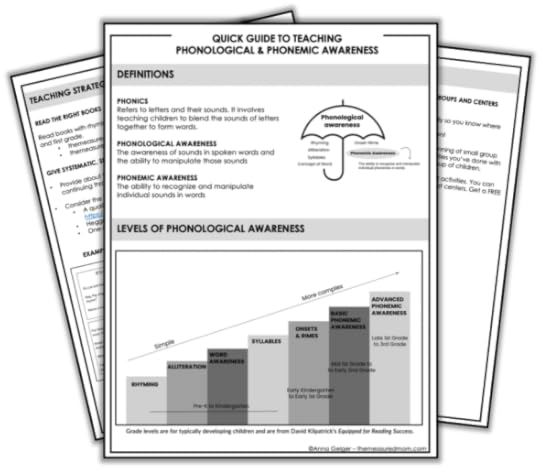 Quick guide for teaching phonological awarenessHeggerty Phonemic Awareness Curriculum
Equipped for Reading Success
, by David A. KilpatrickReading Done Right – free phonemic awareness programFull episode transcript
Quick guide for teaching phonological awarenessHeggerty Phonemic Awareness Curriculum
Equipped for Reading Success
, by David A. KilpatrickReading Done Right – free phonemic awareness programFull episode transcriptTranscript
Download
New Tab
A few weeks ago, I gave a survey to my newsletter audience, and over 3000 people filled it out. The survey was all about questions they had which related to phonological and phonemic awareness. That's why this, our third episode in a series about those topics, is going to answer some of those questions that people asked. I had a lot of fun looking through the survey results and my team member, Regina, went through it and helped me find seven questions that we're going to answer today on the podcast.
Now, the last couple of weeks, if you've watched the videos, there were a lot of slides. It was more of a presentation style. This week is going to be more conversational. It's going to be you and me, back and forth, and I'll put the questions up before I answer them. So with that, we'll get into Episode 32: Answers to Common Questions About Phonological and Phonemic Awareness.
Here's our first question, "What is the difference between phonics, phonological awareness, and phonemic awareness?"
If you've been with us for the past couple of weeks, you're probably saying, "I know. We've heard this enough times already," but I find it's always really important to start with definitions so that we're all on the same page and everyone knows what we're talking about. Phonological awareness and phonemic awareness are not the same as phonics. It's unfortunate that they all kind of sound the same, but they're actually all quite different from each other!
Phonics is what most of us are used to. It's connecting letter sounds to letters on the page. So if you're having a child look at the word, "cat," and you're telling them to sound it out, that's phonics.
Phonological awareness actually comes before that and it's helping kids hear and manipulate sounds in words. Those can be big parts of words, like parts of a compound word, or they can be smaller parts, like the onset and the rime. For example, in the word, "bike," the onset is /b/ and the rime is /ike/.
Then we can get really, really specific when we're into phonemic awareness. Phonemic awareness is working on those individual sounds in words called phonemes. So the word, "fish," for example, it may have four letters, but it has three phonemes, /f/, /i/, /sh/.
You might be saying, "Okay. Why does this even matter? Why can't we just go straight to phonics so kids can learn to read?"
Well, what scientists are telling us right now is that there's something that's happening in the brains of good readers. It's called orthographic mapping. It's a mental process in which they connect those phonemes, so the sounds of each letter or group of letters, to the letters on the page, the graphemes. Kids can't do orthographic mapping if they don't have a solid foundation in phonemic awareness. The point of orthographic mapping is that it helps us remember words in the future. So as an adult, if you see a new word, most likely it only takes one or two times of reading it before next time, it's automatic. We want that for our children as well, but they need to be able to do this process of orthographic mapping. They can't do it unless they first develop phonological and then phonemic awareness. So that's why we're spending so much time on it and why I'm going to answer some more questions about this topic.
Question number two, "Is there a chart or guide that gives an order in which to teach the skills?"
Yes, there is. I have shared it in the past two weeks, and I will share it again now. Here is the chart for you. As you can see, we start with simple to more complex: rhyming, alliteration (those are really early skills), then we move up to word awareness, syllables, onsets and rimes, and then the most complex, phonemic awareness. I'll be giving you a chance to get your own copy of this chart at the end of the presentation, so stay tuned for that.
Let's go back to question number three now, which is, "At what age should you start working on phonological awareness?" That is going to go right into question four, which is, "How long should you keep teaching phonological and phonemic awareness?"
If you're on my email newsletter (which I recommend if you're not because you get a lot of freebies when you're connected to it), I recently sent out an email in which I said that as a teacher, primarily in first and second grade, I did not know the importance of this going past preschool and kindergarten! In fact, it's just kind of a new thing that more people are becoming aware of. Certainly, we start teaching phonological and phonemic awareness when kids are very young. If you have a baby who listens to you read books, you can start building phonological awareness by reading rhyming books. It's as simple as that to start to help them develop an ear for rhyme.
If you're a classroom teacher, you can start doing specific lessons on phonological awareness in pre-K or kindergarten. These would be oral exercises. You would be saying things and kids would be responding back and forth. Last week, I gave you a lot of specific examples about what that would look like.
Now, how long does this go on for? Well, like I said a few minutes ago, as a teacher, I thought that this was just for pre-K and kindergarten and once they were in first grade, I had to get into the business of teaching them to read and we didn't have time to spend on phonemic awareness. Oops! That was a mistake because now, as I told you, scientists are telling us this can be the missing key, the missing link, to helping some kids who really struggle as readers.
While some children will develop it naturally through lots of exposure to rhymes and things like that, others will not. Many will not! So it's up to educators to make sure this is a part of our days all the way through second grade and sometimes even early third.
So let's go back and look at that chart. These age levels here are for typically developing children and these grade levels here are from David Kilpatrick's book, "Equipped for Reading Success". I've talked about that previously, but I want to make sure you know that these are not from my head. These are from a reading researcher. He's telling us that by the time kids get to the advanced level of phonemic awareness, they may still be developing this in third grade. This is for normally developing kids. If you have kids who struggle with reading, they may not even have this in place by fifth grade or sixth grade. However, in regular classrooms, this is what we would expect to see. We would want to see these early levels being taught in pre-K and kindergarten and the more advanced levels from first through third grade.
Let's move on to our next question. Let's go to question five, "For a fifth grader reading at a first grade level, should we invest the time to teach phonological awareness?"
I'll bet you know the answer to that, and the answer is absolutely yes! If it's the missing link, they're not going to be successful in reading until they get it down. If you're wondering, "What can I use?" there are some really good resources out there.
I want to show you one that's my favorite and that's this one, "Bridge the Gap". These are phonemic awareness intervention levels from Heggerty and you can just find them by Googling them online. It's H-E-G-G-E-R-T-Y. They have a shop with these resources that will help you teach phonological and phonemic awareness. They have them for pre-K, kindergarten, primary, and then this intervention book. What I love about it is it's all laid out so nicely and cleanly. At the beginning, they tell you how to do it. They give you teacher tips, and then they've got specific lessons with exactly what to do. I highly recommend it! I think it's under $60, at least right now, which personally, I think is a really good price when you can use this over and over and over and over. Students don't need a copy, it's just for you.
Another option for you is to check the back of David Kilpatrick's book if you own it. It's certainly worth getting, "Equipped for Reading Success". In the back, he has one minute exercises, which are really good. I think it's maybe a little bit harder to know what to do with this, although he does have an assessment online, which can help you. The Heggerty is a little easier to follow, but this is really good as well.
There's also a free program, which I just recently discovered online, for teaching phonemic awareness. It's written by some people I really like and respect, David and Meredith Liben. I've read this whole book and marked it up sooooo much. They talk about teaching the important foundations for helping kids learn to read. It's kind of looking at the science of reading and balanced literacy and how we need to make some changes in how we've been teaching reading. They actually created this free phonemic awareness printable curriculum for you and it's on their website, readingdoneright.org. If you go to their menu on the top, it says, "Phonemic Awareness Program". It's definitely worth checking out and will give you lessons for kids up through second grade. As far as I can tell, they don't have something specifically for kids who are struggling, but I'm sure you'll find something there for older kids if you need it. It's all printable oral lessons, and it's all free, if money is an issue for you. If money's not an issue, I would recommend the Heggerty program. All right, so that was the answer for you for fifth graders that are struggling. Definitely do phonemic awareness activities and use some of those materials!
Number six, "How can I support phonemic awareness once kids are already reading whole words? I feel like they need it, but it feels too remedial or simple for them."
That is a really good question and I want to connect it to our final question, which is, "How do I know what to teach in whole group versus what to teach in small group or literacy centers?"
Here's the thing. Anytime you teach the whole class the same thing, which you're going to be doing if you're using these structured phonological phonemic awareness curricula, you're not going to be hitting everybody. You're going to have kids who can't keep up, and kids that it's way too easy for them and it's going to be boring. It's just a fact of life. The good news is, though, that Heggerty has some really good hand signals that can help keep kids engaged and the lessons are short. We're only talking 10 or 15 minutes per day.
I would not tell you to do something whole class that's going to take an hour. Absolutely not! To me, 30 minutes is pushing it for a whole class lesson when you have all different levels. I can get behind 10 minutes though, and that's why it's really good to have this systematic sequential program so you aren't missing anything. Everybody's getting what is important to know, but, of course, they're not all going to be learning it at the same pace. Some kids are going to need review. Some kids are going to need you to give them something more advanced because they've already got this down. That's where the small groups come in. I would use the whole class time to go through your program - 10 minutes, maybe 15, but I'd really try to keep it to 10. Then I'd make sure I've assessed all my students so that I know exactly what to work on with them in small groups.
If you're doing small reading groups by level, which I prefer to do, then I would make sure that at the beginning of your lesson, you are pulling out some two or three minute phonological or phonemic awareness practice activities. These are oral activities that you do with your students as a way to meet them where they are, whether that's to remediate or to challenge. That's how I would recommend breaking it up. So back to the question about third graders where people said, "It feels a little boring and it feels too easy, but I know they need it." If you're only doing it for 10 minutes, it's going to be fine. It really is. The nice thing about these oral activities is that you change the way you deliver them to make them more appropriate for older kids. It's up to you how you handle it, but it's certainly possible not to make it feel babyish, as long as you're not doing things like puppets or something like that.
I hope that answered the question about when to do what, but you're certainly welcome to reach out to me for more questions about that. In terms of how you know what to do in those small groups, how will you know exactly what skills to do to practice, then I would recommend checking out my free assessment, themeasuredmom.com/assessment, and that will help you find out exactly where your learners are for all levels of phonological awareness. It tests rhyming, alliteration, onset rime, all the way up to advanced phonemic awareness. You wouldn't give that whole assessment to one child most likely, because you'll stop when it's clear that they're struggling or not ready to advance. Then you could give other parts of the assessment at a future date, but that will help you pin down what they need to know.
I also want to let you know about a guide that I'm sharing today. This is free and this will help you keep in one place the things I've been talking about in the last few weeks. It's got the definitions all in one place. You can see here, we've got the chart so you'll be able to see the specific skills in order and what grade levels you should be teaching them. It also contains some specific examples of oral activities. It gives you places or links or names of all the curricula that I recommend. It also talks about book lists, and tells you where to find printable activities that can mix up and enhance your phonological and phonemic awareness instruction.
While I do think that these oral activities are really helpful and useful, I also know that I would go a little crazy if that's all I did. I personally think that as a teacher and as a student, we all benefit from variety. I've created a bunch of printable games and centers that you can use to improve phonological and phonemic awareness, which I talk about in the handout.
This is just a three page document, super helpful and quick, that you can get. The link for that is themeasuredmom.com/guide. So head to that link and you can download this quick guide, including the charts I shared today. I think that's about it! If you would like to check the show notes, or if you're listening on the podcast and you want all these links and everything else, you can find those at themeasuredmom.com/episode32.
I hope you enjoyed today's episode. It was a little more fly by the seat of my pants than I like to do, but some weeks are like that. The good thing is that we had all this beautiful sunshine today. It has been so dreary the past few weeks, so this has been really nice to do a training in the sun. Next week, I have something very special for you. I'm going to share some tips for teaching phonological and phonemic awareness virtually because if you're watching this in 2020, many of you are in that position. Schools are closed because of the virus, and you need a way to teach over the computer, so I'm going to help you with that next week. Thanks again so much for watching and I will talk to you again soon!
Scroll back to top
Sign up to receive email updates
Enter your name and email address below and I'll send you periodic updates about the podcast.
powered by
Link to original Facebook Live presentationVideo presentation
The post Answers to common questions about teaching phonological and phonemic awareness appeared first on The Measured Mom.
January 18, 2021
The 3 Keys to teaching phonological awareness
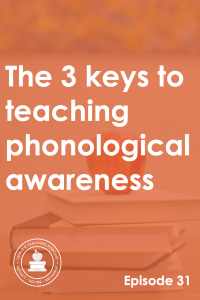
It’s time to get practical!��In this episode you’ll get specific steps and strategies for teaching phonological awareness from Pre-K to early third grade.
In this episode I��will share …
My favorite read alouds that build phonological awarenessMy top recommendations for phonemic awareness curriculaHow to keep phonological awareness fun with printable centers and gamesListen to the episode hereBook ListsFavorite rhyming booksFavorite books with alliterationRecommended Resources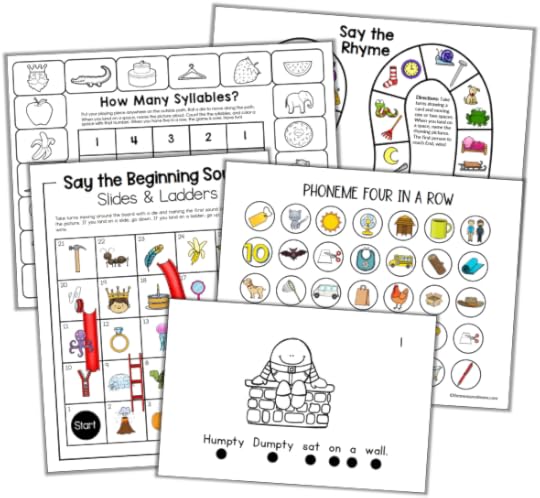 Free sample of phonological and phonemic awareness activitiesPhonological & Phonemic Awareness Super BundleHeggerty Phonemic Awareness Curriculum
Equipped for Reading Success
, by David A. KilpatrickFull episode transcript
Free sample of phonological and phonemic awareness activitiesPhonological & Phonemic Awareness Super BundleHeggerty Phonemic Awareness Curriculum
Equipped for Reading Success
, by David A. KilpatrickFull episode transcriptTranscript
Download
New Tab
Hello my name is Anna Geiger and I want to welcome you to this live presentation. I am a former teacher, now serving parents and teachers through my website, The Measured Mom, my membership, The Measured Mom Plus, my Facebook groups, my online courses, Teaching Every Reader and Teaching Every Writer, and my podcast, Triple R Teaching. In the podcast, I help educators reflect on their current practices, refine by making small doable changes, and recharge so they're excited for the next day in the classroom.
You are listening to the second of a series all about phonological and phonemic awareness. Last week we talked all about five things you may not know about phonological awareness. Today, in Episode 31 of the Triple R Teaching podcast we're going to talk about three keys to teaching phonological awareness. If you're listening to this in the future on the podcast, then you're hearing the audio of the Facebook live presentation. If you want to see or get a link to the video, you can head to the show notes which can be found at themeasuredmom.com/episode31.
With that, let's go ahead and get into the presentation. I want to share my screen here. Now last week's presentation was all about laying the foundation, the groundwork, the theory behind WHY we do this. We talked a lot about how phonological awareness is really key to helping students become strong readers down the line, mainly because of phonemic awareness. We talked about orthographic mapping. There is a lot of deep stuff there, but it's a really important foundation for what we're going to talk about today. If you haven't seen or listened to that podcast, I would go back and check it out, it's Episode 30.
Today I want to talk to you about three keys to teaching phonological awareness:
#1- Read the right books to your students.
#2- Give systematic sequential instruction in phonological awareness.
#3- Include phonological awareness activities in centers and small group lessons.
Now before we dive into this, I want to do some reviewing of definitions and I know you're thinking you already know what all the words mean. Some people are listening to this video without having seen the first one, so I want to just do a quick review.
Phonics refers to letters and sounds. It's what we're talking about when we talk about sounding things out. It involves teaching kids to blend sounds of letters together to form words, whereas phonological awareness is an oral skill. So phonics is working with print, and phonological awareness is hearing. It's hearing spoken words and being able to manipulate the sounds in the words. Phonemic awareness is a very specific phonological awareness skill. It is the most complex because it involves recognizing individual sounds - not just parts of a compound word or an onset or a rime, but the INDIVIDUAL sounds.
You might remember this umbrella graphic which we shared last week. It says that phonological awareness has to do with rhyming, alliteration, syllables, concept of word, onset-rime, and phonemic awareness. So phonemic awareness is a piece, and many would say the most important piece, of phonological awareness.
We also had this staircase to show you all the levels of phonological awareness, starting very simple with rhyming, and going more advanced following up the staircase to advanced phonemic awareness.
We talked also about the very basic levels of phonological awareness, which are rhyming and alliteration. Because those are very basic and best taught to our youngest learners, for example, pre-k and kindergarten, it's a really great time to read them a lot of books that can help them build these skills.
I want to share with you some of my favorites. First of all, there is no end to quality rhyming books. There really isn't! There are SO many out there. Some of my favorites include "Duck in the Truck" by Jez Alborough. If you know this book, it's about a duck whose truck gets stuck in the muck, and different animals come and help him out. It's funny and cute, and what's really nice about it is that it works really well for leaving out the last word of a sentence for kids to fill in. What I especially like about this book is that it's so popular that kids will just listen to you read it over and over, and that's really what they need. They need to listen to you read the book many, many times for them to be able to hear the rhymes and produce them themselves.
Another book that I really enjoy is "Rhymocerous" by Janik Coat. This is different than "Duck in the Truck" because in this one it actually supplies the rhymes. It's like each page is a rhyming pair, so it's quite different. It doesn't tell a story, but it's very engaging and has great pictures. I highly recommend it.
Then if you want a more advanced rhyming book, one that is just a great story that kids will listen to repeatedly, but not a simple as "Duck in the Truck", I would check out "The Gruffalo" by Julia Donaldson. Really pretty much any book by her is great, and I think most, if not all, are rhyming books.
Now that's just to get you started. I'm sure you need more than three, so please check out my blog post "75 Best Rhyming Books". It's quite a list, but there are so many good ones! You can find that list at themeasuredmom.com/rhyming books.
So how often should you read rhyming books? If you're in a classroom, I would read one every day. At home, certainly have a stack that you use often and just know that constantly reading these rhyming books will help your learners develop an ear for rhyme.
Now for my favorite books with alliteration. Remember, alliteration is when kids can hear that words start with the same sound. It's harder to find good books with alliteration, but a favorite author of mine for these is Pamela Duncan Edwards. A really funny one that she's written is called "Some Smug Slug". It's about a slug who's smugly climbing up this slope, and everyone is telling him it's dangerous, and to get down, but he's smug about it and keeps going. It turns out, the slope is actually a toad, so it's hilarious. Another good book by the same author is "Four Famished Foxes and Fosdyke", and it's also super funny. It's really hard to write a good story using the same letter at the beginning of a lot of words, but she's got it figured out and she's got a few that you should check out.
Another idea is "The Great Fuzz Frenzy" by Janet Stevens and Susan Stevens Crummel, who are a great team. This is a hilarious book. I can't remember, it's been a while since I read it, if they're their prairie dogs, but a tennis ball has rolled into their tunnel and there's just a big frenzy about getting all the fuzz. They are all excited about it, so it's super funny.
If you want more books with alliteration, you can check out my blog post, themeasuredmom.com/alliterationbooks. The funny thing is that when I made this list, I was actually thinking about students who are writing and how alliteration is an example of writer's craft. It's something they can do to make parts of their writing stand out more. I didn't really think about it as being a phonological awareness skill, but looking back I can see many, many books in that list would also work for this as well.
So that is the beginning, that's the first key- reading aloud a lot to your students.
Let's move on to number two, which is to give systematic sequential instruction in phonological awareness. Now, I'm just going to be honest here, but I have to say that for many years the phrase "systematic sequential" kind of gave me hives because to me that just sounds BORING. For me to enjoy teaching, it's got to be interesting! So if you're feeling that way, I totally get it! The good news is that systematic sequential phonological awareness instruction doesn't take long, you can accomplish it in 10 or 15 minutes a day.
To be able to do that you need to remember all the levels of phonological awareness that we talked about last week. Let's just review those briefly: rhyming, alliteration, word awareness (that's when kids can count the words in a sentence), syllables, onsets and rimes (remember an onset is the first part of a syllable before the vowel and rime is the second part. So with the word lamp, the onset would be /l/ and the rime would be /amp/), and then basic and more advanced phonemic awareness. Those involve things like isolating phonemes, blending, segmenting, and manipulating.
So when we think about that staircase of skills there's a few things to remember. It's not one hundred percent accurate one hundred percent of the time. It's a general progression. In other words, some kids have those more advanced skills before they have some of the basic ones, it's just kind of a weird thing. So it's not true that everybody follows through that progression always exactly in that order, but it's pretty standard.
The next thing to remember about this is that phonemic awareness is the ultimate goal, but we should not try to skip the foundational skills. In that long ladder, we know that phonemic awareness comes at the end, and we're excited about that, but we shouldn't try to skip the first ones to get there faster.
Phonemic awareness is the KEY to helping kids with orthographic mapping. We talked about that last week. It's this idea that they map words into their brain so that they can read them automatically next time, but we need those things to build up to it first.
Finally, phonological awareness instruction should begin in kindergarten and continue to early third grade, perhaps longer. I mentioned this in an email that I sent to my newsletter subscribers last week, but as a classroom teacher of first and second grade, I did not do a lot of this. I really thought that it was taken care of in preschool and kindergarten, and my job was to get right into reading. I didn't realize that they could coexist, and that they need to be building this phonological awareness, specifically phonemic awareness instruction, for a while! That's something for you to remember too if you thought that that's just for the very early childhood teachers. Think again, many experts are telling us now, because it's the key to helping kids who struggle with reading.
So if you're listening to all this and you're saying, well, that's great, but I need some examples! What exactly does it mean to teach phonological and phonemic awareness systematically, explicitly, sequentially, give me some examples! That's what we're going to do next.
Alright, so I'm going to give you some oral activities that you can do for each of those skills in that staircase. First, let's start with rhyming. You go very basic and ask them if two words rhyme, and then you can get more advanced. Here's three things you can do. "Do 'cat' and 'bat' rhyme?" You can do an odd one out, "'bag', 'pig', 'dog', which one doesn't rhyme?" Or you can have them generate rhymes, you can say "Name a word that rhymes with 'run'."
Let's go up the staircase to alliteration. You could ask, "Do these words start with the same sound, 'bug', 'ball'?" You could say, "'Bear', 'gum', 'goat', which one starts with a different sound?" Or you can say "What sound does the word 'horse' start with?"
Moving up the staircase let's go to word awareness. So in this one you could just give them a sentence and have them tell you each word, or count the words. It can help to give them some pennies or poker chips that they push forward for every word. So I could say, "How many words are in the sentence, 'I ran to the store'?" and then help them push a penny forward for each word.
Next up is syllables. When it comes to syllables, we can have them put them together to make words, or we can have them break a word apart into syllables. We can have them omit syllables, and we can have them substitute syllables. Let me give you some examples. You could say, "Put these words together to make a word, 'fish', 'bowl'," and they would blend the syllables to make fishbowl. You could ask them, "Break this word apart into two words, 'airplane'." That would be an example of segmenting with syllables. You could say, "What is 'doghouse' without 'house'?"The answer is dog. For substitution, you could say, "Take the word 'playground' and change the word 'ground' to 'house'." They would give you the word, "playhouse".
Next we'll talk about onset and rime so again we're going to talk about blending, segmenting, and omitting. You could say, "Listen to these two sounds and put them together to make a word, /c/, /at/", and they would say "cat". Or you could say "What are the two parts of the word 'house'?" and they could give you the two parts, /h/ and /ouse/. Then "What is 'can' without the /c/?" and they would say, "an".
When it comes to phonemic awareness, there are so many different pieces about them so I provided a whole slide for all four parts of phonemic awareness with examples. First, we can start with phoneme isolation, which is a lot like alliteration when you're talking about the first phoneme. You could say, "What sound does the word 'hippo' start with? What sound does the word 'bird' end with?" Or you can have them listen to the words and tell you which one is different, "Listen to these words, which one has a different middle sound, 'rip', 'win', 'pop'?"
Moving on to phoneme blending, that's a little more advanced. You could have them listen to the sounds and put them together to make a word, so "/ch/, /e/, /st/" and they would blend them to make the word chest. Of course, you would start with two or three letter words and work your way up to longer ones.
Then we've got phoneme segmentation. It's the opposite of blending, we're to take a word apart into its phonemes. So you could say, "Break this word apart into its sounds, 'hat'. /h/, /a/, /t/." Or "How many phonemes are in the word 'stand'?" Then you could watch them or help them /s/, /t/, /a/, /n/, /d/. Remember with phonemes when we're counting them, a digraph is one phoneme. So /sh/ is spelled with two letters, but /sh/ is just one phoneme because it's just one sound.
Remember that even though we may sometimes include letters with phonological and phonemic awareness instruction and that's okay, but in general, these activities are purely oral.
Then we've got phoneme manipulation, which is the most advanced of all the phonological awareness skills. Last week I talked to you about David Kilpatrick and his research, and he talks a lot about how this is the big one in terms of helping kids who struggle. We really have to help them learn to how to manipulate phonemes. Some examples of that would be "Add /s/ to the beginning of 'pin' and what's the new word? Spin!" That would be adding a phoneme. Or you could say "Take the /l/ out of 'plug,' what's the word? Pug!" That would be deleting a phoneme. Finally, "Take the /l/ out of 'molt' and substitute /s/. What's the word? Most!" That's substituting phonemes.
As you can see there are four pieces to phonemic awareness. We need to work on all of them, but we need those foundational skills too.
Now if you are interested in finding a sequential systematic phonemic awareness instruction curriculum, I have a few to recommend. The reason I call this "phonemic awareness" and not "phonological awareness" curriculum is because that's what these creators call it. For sure the first one I'm going to share with you includes plenty of rhyming, onset-rime, and all of that which is not technically phonemic awareness, but it is also included. The first one I'm going to recommend, that a lot of people love, is "Phonemic Awareness" from Heggerty. I don't have it in my hands yet, but I have ordered it so I can see it and see what all the buzz is about, but I've seen their previews on the website. If you go there you can get downloads with the scope and sequence as well as sample lessons. The nice thing is that it comes on this big spiral, and they have a separate curriculum (35 weeks worth) for pre-k, kindergarten, primary, and an intervention binder which I'm assuming you could use in third grade. Don't quote me on that, but it's certainly worth checking out. What's nice about it is that it has a set of oral activities for each day, and they tell you it should only take about 10 or 15 minutes, and that sounds good to me. Heggerty also teaches hand signals which can help keep your students engaged.
Another one is David Kilpatrick's book, "Equipped for Reading Success". I just think this is a good book to have in general, to help you understand more about phonemic awareness and why it's important, but at the end, he's got a whole bunch of one minute activities you can do with your students. I would say it's not as straightforward as Heggerty in terms of what to do when, but it's still an excellent resource.
Now with that I'm going to go to my face and take out the slides. I want to say that I think it's a really good idea- an important, smart idea- to get a systematic, sequential, phonemic awareness curriculum and use it in your classroom. Particularly if you teach pre-k to second and even third grade as well. I also think it's important that you keep this whole class instruction short. 10 minutes would be my goal for you, maybe 15. There are so many other things to do in your day, so I would go for 10 minutes. I also know though, that as a teacher if I had to read out of a binder a set of things that follow the same pattern every day, I would get a little bored! Some of your students may get bored as well! So yes, it's important, but I think it's also important to supplement with other things. I wouldn't make that be ALL you do for phonological awareness because you may find that some students get bored with the repetition of it. Then they tune out a little bit, and you need other things to keep their attention- just to keep learning fun for them AND you! You became a teacher because you're creative, not because you want to follow a list of To-Do's every day.
That's why I think that Key #3 is also very important: Include phonological awareness activities in your centers and small group lessons. These would be things that include paper, so it doesn't have to be one hundred percent oral all the time. There are lots of hands-on, colorful things that you can do to help your students learn this in another way.
Let's go on to some ideas for phonological awareness activities and centers. I like board games. I think they're fun, kids like them, I actually used this exact board game with my daughter when she was struggling to learn how to rhyme. She was three, and she was our fifth child. The other ones all picked up rhyming without me really teaching it directly, because I was reading to them all the time! But as our family has grown, I haven't done it as much, with all the kids. All of you with big families, or even more than one child, probably know what I'm saying. It wasn't as explicit as it could have been. So I made this game and we just took turns moving around the board and all she did was land on a space and say the two pictures "star, car," "flag, bag". It was great and this worked! This simple game worked! All of a sudden, she understood how to rhyme. We played it a few times and that was it.
There's a quite a few other things you could do to work on rhyming. These clip cards are a good one for kids just learning. I have some on my website, and you can certainly find them for free if you search on Pinterest. These sorting cards are an activity where you would have a mat with smiley face on one side and a sad face on the other side, and a set of cards. Each card has two pictures and they rhyme or they don't rhyme. Kids will draw a card, name the pictures, and sort them. Bingo is a great whole class activity for teaching rhyming.
Moving on to syllables, clip cards are another good one. This is a board game I like. I've created many, many board games with this similar pattern with a border on the outside of spaces and the inside is a bingo board. Kids can play it all by themselves. They just move around the border using a die, and when they land on something, they find its match in the bingo center. In this version, if you're listening and not seeing it, the outside are pictures that have one to four syllables in their names, and the inside is a grid of numbers. They just go around and if they land on ambulance, for example, they clap it "am-bu-lance", and they color the three in the center. When they have five spaces covered in a row, they are done! It's nice because they can play without you.
I like this syllables board game which is a lot more advanced. Kids roll a die, and they move to the next picture which has that number of syllables. So if they roll a four, they might move up to u-ni-cy-cle. If they roll a five, they lose their turn. If they roll a six they roll again. Then, we have good old worksheets. I'm not a huge fan of worksheets, certainly not a steady diet of them, but I'm not going to tell you they're evil and you should never use them. I don't believe that. So, they're certainly there for you. They are not my first choice, but they're something when you need something quick.
When it comes to concept of word, I really think the best way to do this is to teach with a little book. A nursery rhyme emergent reader is a good way. This would be an example, it's "Humpty Dumpty", and there is a dot under each word. I like to use nursery rhymes because kids know them, at least many kids do. If they don't know them, then read to them, and once they know them you can use these little books. They can point to each word as they read and they're not really reading, they're reciting, but it helps them match every word they say to a word on the page.
There's a lot of activities for phonemic awareness. Here's one example for phoneme isolation. My kids have always loved chutes and ladders. You can make a really simple version of that on a piece of paper and put pictures in each box. When they get to a picture they have to say the first sound of the word. You could do a blending activity where they have a game that has a whole bunch of different pictures on it. So think of a grid with eight pictures. You say the three sounds that go in the word, and they have to find it. I actually did this exact type of activity with my son and his friend today at our home preschool. He is five, and she is almost 4. I would say, "/p/, /i/, /g/," and they had to put the sounds together to make "pig" and then cover the pig on their board.
Here's an example for phoneme segmenting. Do you have Elkonin boxes? Those are the cards that have a picture on the top and boxes on the bottom for each sound. If you've got Elkonin boxes at home, you can repurpose those into a game. Just get a blank game board. Kids would say all the sounds in the word, and then they would move ahead on the game board the same number of sounds that were in the word. They just flip an Elkonin box card, and if it has a picture of a bee on it, they say, "/b/, /ee/", and then they moved two spaces on the board. It's a way to get extra mileage out of those cards.
Then for phoneme manipulation, here's another example of a game. It's a little hard to explain to those of you are listening on the podcast, but each space has a picture and a letter to add to the beginning of the word. So in this case we're using letters a bit, but by this stage they're at an advanced stage of phonemic awareness, and they should know the letters and sounds for sure.
Let's review the three keys I talked about today that I believe are important in teaching phonological awareness. They are reading the right books giving systematic sequential instruction in phonological awareness, and including phonological awareness activities in your centers and small group lessons. Now I told you what kind of books to read and I gave you some links to book lists that should be helpful. I recommended some systematic curricula for teaching phonological, and specifically phonemic awareness.
Now I'm going to help you with number three. I want to help you get your hands on some centers and small group activities that you can use that can make phonological awareness FUN for you and your students! I want to share my Phonological and Phonemic Awareness Super Bundle! I've put together six products from my shop, and dropped the price by 33% in this big bundle. I want to share with you what's included. We've got my Rhyming Activities that's normally for $15. Syllable Activities are $10. The Phonemic Awareness Bundle is $24. My Nursery Rhyme Pack, which includes things like the "Humpty Dumpty" book you saw earlier, plus a lot of corresponding activities is $15. Set 2 of those which I just released is also $15, and Personalized Emergent Readers where kids can actually have their name in the book, as the first word on every page. All of these together is a combined value of $89, but in the bundle it's put together for $57, so I would like to offer that to you in my shop. It's called the Phonological Awareness Super Bundle for $57. If you're not sure yet, or you want to try before you buy, check out this free sample. You can get it at themeasuredmom.com/sample, and it includes a rhyming game, a syllables game, two phonemic awareness games, plus an emergent reader. I would definitely check that out and that way you can get your hands right away on some engaging activities that you can use in your centers or your small groups.
So there you go! Those are my three keys to teaching phonological awareness. If you are listening on the podcast and you want links to things I mentioned, you can go to themeasuredmom.com/episode31. If you're live with me on the video, that won't be ready for a couple more days. Thank you so much for watching, and I look forward to talking to you again next week!
Scroll back to top
Sign up to receive email updates
Enter your name and email address below and I'll send you periodic updates about the podcast.
powered by
Link to original Facebook Live presentationVideo presentationImages from the video presentation
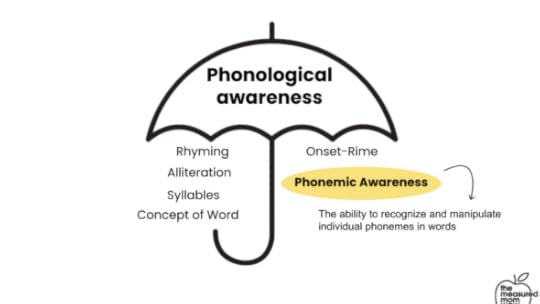 The difference between phonological and phonemic awareness
The difference between phonological and phonemic awareness
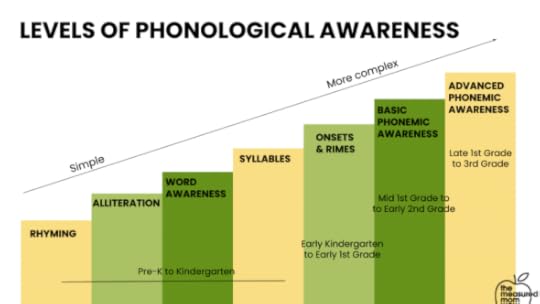 Staircase visual for the levels of phonological awareness
Staircase visual for the levels of phonological awareness
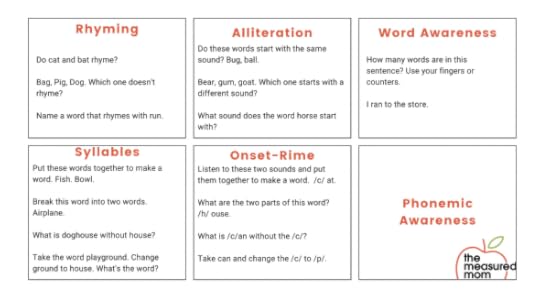 Specific activities to build phonological awareness
Specific activities to build phonological awareness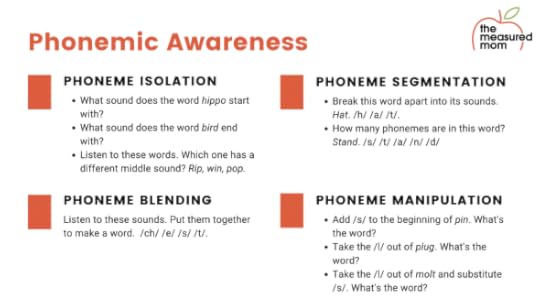 Specific activities to build phonemic awareness
Specific activities to build phonemic awareness
The post The 3 Keys to teaching phonological awareness appeared first on The Measured Mom.
January 10, 2021
5 Important things you may not know about phonological awareness
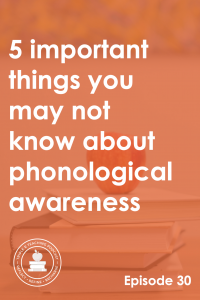
TRT Podcast#30: 5 Important things you may not know about phonological awareness
What’s the difference between phonological and phonemic awareness, and why are they so important for reading success?
Learn exactly how old our readers should be when they develop phonological awareness.
Find out why phonemic awareness helps build a sight word vocabulary.
Begin to understand orthographic mapping and the science of reading.
Listen to the episode here
Recommended Resources
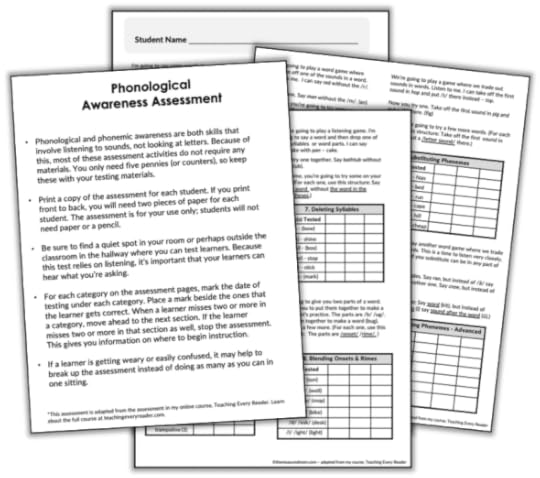
Free phonological awareness assessment
Phonological & Phonemic Awareness Super Bundle
Equipped for Reading Success , by David A. Kilpatrick
Full episode transcript
Transcript
Download
New Tab
What exactly is phonemic awareness, and why is it vital for future success in reading? Today's episode will uncover the difference between phonological and phonemic awareness, we'll discuss the age range at which we want to see them develop, and we'll explain exactly why one very specific part of phonemic awareness makes all the difference when it comes to future success in reading.
Today's episode is going to be a little bit different. I recorded it last week as a Facebook live. As I recorded it, I was using slides, and you'll see me reference them throughout the presentation. Don't worry, you will still get a lot out of this episode. If you'd like to check out the slides, you can find those linked in the show notes. We've got a lot of exciting things to talk about today. Let's get started.
Hello, my name is Anna Geiger, and I want to thank you for joining me for this live presentation. I am a former teacher currently serving parents and teachers on my blog, themeasuredmom.com, my membership site, The Measured Mom Plus, my Facebook groups, my two online courses, Teaching Every Reader and Teaching Every Writer, and my podcast, Triple R Teaching. In my podcast I help educators reflect on what they're currently doing, refine by making small simple changes, and recharge, so they're excited to get into their classroom the next day.
If you're watching this with me on Facebook, you are seeing a live recording of a future podcast episode. When we're finished with this live video, we'll take the audio and put it on the podcast. What you're actually listening to is episode 30 of Triple R Teaching, and this kicks off a podcast series all about teaching phonological awareness. If you're listening to this on the podcast in the future and you would like to see the visual slides that go with the presentation, just head to the show notes and I'll link to the video. You can find the show notes at themeasuredmom.com/episode30.
With that, we're going to get started with the presentation. We're on episode 30: Five Important Things You May Not Know About Phonological Awareness.
We'll start with this one. Phonological awareness is NOT the same as phonics. If you hear that and say, "Well yes, I knew that already," hang with me here. I just gave a survey to my email audience and over 3,000 people responded. Many of those people were unsure of the difference between phonological awareness, phonics, and phonemic awareness. There's just so many words that sound the same, so let's go ahead and give some definitions here before we get deeper into the presentation.
Number one: phonics, as you know, refers to letters and their sounds, and it involves teaching children to blend the sounds of letters together to form words. Whereas, phonological awareness is the awareness of sounds in spoken words and the ability to manipulate those sounds. Phonics refers to printed words, whereas, phonological awareness has to do with spoken words.
Now if you're hearing that and wondering, "Okay, but where does phonemic awareness fit in?" you may have heard me share the umbrella analogy before. Phonological awareness is like an umbrella because it covers a variety of skills, and those include rhyming, alliteration, syllables, concept of word, onset and rime, and phonemic awareness.
By alliteration, I mean kids can hear that two words start with the same sound. If you said, "Do 'bear' and 'ball' start with the same sound?" they would say yes and they could tell you they both start with /b/. Now, they could not necessarily tell you that they start with the letter B, but that's okay, this is an oral skill we're talking about right now.
Syllables, we know what those are, and this involves being able to put them together to make words and take them apart. If a child can clap the syllables of her name, Sa-man-tha, she has this skill.
Concept of word is another important piece of phonological awareness. That would be if you can give a child a very simple sentence like, "I have a new dog," and they could break it apart into words.
Then we have onset and rime. If you're looking at the slides with me and you're thinking, "She's spelling rhyme wrong," I'm not, but this is the way you spell it when you're talking about an onset and rime. An onset is the first sound in a syllable before the vowel and the rime is the second part. In the word "bike", /b/ is the onset and /ike/ would be the rime.
Finally, we get to phonemic awareness. As you can see with this visual, phonemic awareness is a piece of phonological awareness. The definition of that is the ability to recognize and manipulate individual phonemes in words. A phoneme is an individual sound. In the word "cat", we have three phonemes, /k/, /a/, /t/. Whereas in the word "fish", which has four letters, we still have three phonemes, /f/, /i/, /sh/. Phonemes don't have to do with the letters, they have to do with the individual sounds that we hear. Phonemic awareness is very important when it comes to future success in reading, and we're going to get into that quite a bit in today's presentation.
Number two: the second thing you might not know about phonological awareness is that there are developmental levels of it. In the survey, one of the big things that people asked was, "Can you give me a scope and sequence for phonological awareness?" What I have for you now is this staircase, and this shows you the progression from simple to more complex phonological awareness skills. They don't always occur in this order, but this is a general idea.
First we have rhyming, then the alliteration piece where I talked about how kids could hear that words start with the same sound. Possibly, if you gave them a group of words like "ball", "bat", and "car", they could tell you which one doesn't start with the same sound. Then we have word awareness, which is being able to break a sentence apart into words. Syllables, taking words and breaking the syllables apart, and then putting syllables together to make a word. Then we have onsets and rimes, so here's where we're getting even deeper. This could be parts of a syllable, so the first sound of a word before the vowel and then the second part of a word.
Then here, we finally get to phonemic awareness, and I have divided it into two levels here on the staircase, basic phonemic awareness and more advanced phonemic awareness. The reason I've done that is because often we get stuck on the more basic skills, like blending and segmenting, and forget to spend some time on the more advanced phonemic awareness skill of manipulation, which, as we'll get into later, is really key for helping students become strong readers.
If you're wondering when these things occur for different grade levels, pre-K to kindergarten typically is when children develop rhyming, alliteration, word awareness, and syllables. They develop onset and rime knowledge in about early kindergarten to early first grade. Then the phonemic awareness happens first in mid-first grade to early second grade, and then the more advanced skill is not until late first grade to third grade.
If you're wondering where I'm getting these grade levels from, I want to share a book with you. I'm going to switch here to my face so you can see what the book looks like. This book is by David Kilpatrick. It is really excellent for helping break down all the things I'm explaining today, and at the end he's got a whole bunch of one-minute activities you can do to build phonemic awareness. It's a really good book to add to your library, "Equipped For Reading Success".
The next thing we want to learn today, number three, is that when it comes to predicting future success in reading, phonemic awareness trumps all! It really is the key. If you go back and look at this previous staircase slide that I was sharing, you'll notice that phonemic awareness doesn't usually occur until later. I think a lot of times, certainly when I was a teacher, I had this idea that phonological awareness is for the preschool and kindergarten teachers and now that I'm teaching first grade, I don't have to do much with it. But as you can see in this chart, it's really important that we continue that instruction, especially phonemic awareness instruction, up until early third grade, and for some struggling readers, past that time.
Phonemic awareness really is important when it comes to future success. Here's a quote from David Kilpatrick from that book I just shared. "Unless students master the skills at the phoneme level, you will not see the desired effect on reading."
One thing you might be wondering is that if kids need phonemic awareness to do well in reading, is it really important that they have all those other earlier skills? That was a question that I received in my survey. Some people said, "Well, I've heard that rhyming is really important for learning to read, but now they're telling us it's not that important, and phonemic awareness is more important."
Well, that's a really good question. Rhyming is important, because as you can see here, it's part of the staircase that leads to phonemic awareness acquisition. It is important because it leads to phonemic awareness! It's an important foundation, but if you want to directly point an arrow to which one has the most direct effect on reading success, that would be phonemic awareness.
You should know that there are distinct levels of phonemic awareness, and I'm going to talk about those with you right now. I'm going to use this ladder visual to explain the levels of phonemic awareness.
The first one is phoneme isolation. This brings us back to the alliteration piece in the phonological awareness staircase. Phoneme isolation has a lot to do with that. It's when kids can hear individual sounds and words, including the first sound, as we did with alliteration, but it also includes middle sounds, ending sounds, and being able to tell whether a word has a different sound in the middle, end, and so on.
Next, we have phoneme blending. If you said to a child, "I have these sounds, /m/, /a/, /t/. Put them together to make a word," they could tell you the word "mat".
Segmenting is taking that same word apart into its individual sounds or phonemes. If you've seen Elkonin boxes before, you've certainly seen this in action. It's a card where there's a picture on the top, and on the bottom, there are spaces for children to put little counters for each sound. I have a set of these for free on my website. One picture might be a picture of a bee, and even though "bee" has three letters in its name, there are only two phonemes, /b/ and /ee/.
Finally, we get to phoneme manipulation. This is the biggie according to David Kilpatrick and some other researchers. It includes things like adding phonemes, deleting phonemes, and substituting phonemes. This is definitely an advanced skill. Many children who are later readers, maybe in fifth grade, and who really struggle, it's very possible that they don't have phoneme manipulation in hand. They're going to need phoneme manipulation instruction too.
For an example of a phoneme manipulation activity, if I said to a child, "Take the word 'bug' and change the /b/ to /r/," they could tell me "rug". That would be an easier one. It would get more difficult if you start adding things like blends. If I said, "Take the word 'stem' and change the /t/ to a different sound," and they would have to change it, then it gets a little more complicated. Then you start working into the vowels and ending blends. Start simple, but there's a lot of levels within this skill as well. So phoneme manipulation is the big thing when it comes to helping students be successful as readers.
The last thing I want to talk about today, the fifth thing you may not know about phonological awareness, is a biggie. Phonemic awareness is central to developing a large sight word vocabulary! This is kind of a new concept for a lot of us, certainly for me, and it's being shared by researchers like David Kilpatrick. It's important to understand, because it's kind of hard at first glance to figure out why phonemic awareness would be important for reading, and, for that matter, why would it be important for developing a sight word vocabulary. Phonemic awareness is oral, what does it have to do with reading words? That's what I want to talk to you about here.
The first thing is to know about some mixed case studies that David Kilpatrick references. That means that they gave students words in all lower case, as in the slide here, "apple", and then they gave them the same words in mixed case, like "ApPLe". Once the students were used to reading words in mixed cases, they could read words on slides with no problem, just as fast, whether they were lowercase or mixed case. I'm sure you can also think about how you can read words in any different font. You can read words in cursive, and you can read them in print just as quickly. It's not that we made this perfect exact visual image of words in our brain. A lot of us might think that students have developed almost a catalog images for all the words they know. That's really not the case.
Instead, David Kilpatrick tells us they have a skill called orthographic mapping. It's a process in their brain. Orthographic mapping is a little bit hard to wrap your brain around at first, if you're new to the term, so I'm going to try to make it really simple for you. It is a mental process, according to Kilpatrick, that we use to permanently store words so that we can recognize them instantly. It's a mental process, so you could not go to your lesson plans and write down, "Today we're doing orthographic mapping." It's not an activity, and it's not a teaching technique. It's a mental process. It's something we do in our heads, and our students can do orthographic mapping if they know how to break a word apart into its sounds. In other words, if they have phonemic awareness.
To get a little deeper on that, according to Kilpatrick, "Letter strings in a meaningful order (written words) can be anchored into permanent memory if the reader is able to recognize why those letter strings are meaningful and are in that particular order."
"Children," this is another quote from David Kilpatrick, "who struggle with phonemic awareness, struggle with reading. Why? Because they do not notice the logical/meaningful relationship between the word's pronunciation and the letters used to represent that pronunciation in print."
Okay, I'm going to switch to my face a minute here. How's it going? Is that making sense to you? I think I had to read that quite a few times to nail it down in my brain. But the idea is that the word "bat", for example, /b/, /a/, /t/. If a kid can look at a word and in their brain subconsciously somehow know that each of those letters has an individual sound and they go in that order, then they have an anchor to remember that word in their head.
I watched a webinar by David Kilpatrick, and one thing that really stuck with me was when he talked about how kids who have the skill of orthographic mapping only need to see and read a word one to four times and then they can just instantly have it. That's true for us too, even as adults. If you read a new word in your reading, it only takes a couple of times of seeing it before it instantly is part of your sight word vocabulary.
There's one thing I forgot to mention before, but it's really important. When I talk about sight words here in this context, I'm talking about words that when you read them, they are automatic in your brain. It doesn't matter if they're phonetic or if they're not phonetic. If you see those words and know them, you don't have to sound them out, you just know them instantly! They are in your sight word vocabulary. That's what we want for our readers. We want them to have a big sight word vocabulary, because kids with a big sight word vocabulary are fluent readers. Then if they are fluent, fluency is the bridge to comprehension, so then they can understand what they read. Building up this large vocabulary of words you can read right away leads to fluency, which leads to comprehension, which is the goal of reading.
Maybe these slides will help you to understand those concepts a little bit more. Phonics is decoding, it's taking a word and breaking it apart into individual sounds. Whereas, orthographic mapping is encoding, it's taking the pieces and putting them together. According to Kilpatrick, phonics is part to whole, phonemes to words. Orthographic mapping is whole to part, it's thinking about the oral words and the individual phonemes that make up the words. Now, to be clear, kids are doing this automatically, but we want to give them the foundational skills so they can do this automatically. We need both phonics AND orthographic mapping to both read and store words, to create sight words from words that were initially unfamiliar.
Let's go ahead and review the five things we talked about today in the podcast; five things you may not know, but now you DO know, about phonological awareness. Number one, it's not the same thing as phonics, because phonological awareness and phonemic awareness are oral skills, whereas, phonics is something that has to do with written words and sounding out words. Number two, there are developmental levels of phonological awareness. I shared that staircase with you and talked about the approximate age range that average readers acquire those skills. Number three, when it comes to predicting the future success in reading, phonemic awareness trumps all. It is the biggie! We talked about the distinct levels of phonemic awareness. We talked about isolation, blending, segmenting, and the big one, manipulation. Finally, phonemic awareness is central to developing a large sight word vocabulary. The reason for that is because when you have phonemic awareness, you are able to do orthographic mapping, this mental process in which you store words so that you can read them in the future effortlessly.
If you want to learn more about this big topic, I'll be sharing more about it in future weeks. One more thing you could do if you'd like is get your hands on this book, "Equipped For Reading Success" by David Kilpatrick. Also, stay tuned for future episodes because each week I'm going to be coming to you with another visual presentation, as well as podcast episode, all about phonological awareness. Stay tuned for that coming next week.
I also want you to know about a free offer for you, my Phonological Awareness Assessment. You can get that by going to my website, themeasuredmom.com/assessment. If you do that, you will find yourself on this page where you can sign up below for the assessment. It assesses all of these pieces of phonological awareness, and it's free!
When you do that, when you sign up for my newsletter and get the assessment, you will get a special offer for my Phonological and Phonemic Awareness Super Bundle. This includes rhyming activities, syllable activities, a huge bundle of phonemic awareness activities, a nursery rhyme pack that helps kids get excited about reading and matching words to print, my second nursery rhyme pack, which was just recently published, as well as personalized emergent readers. With these you can type in student names and then their first name is always the first word on each page. That's a great resource also for developing concept of word. Go head over to get that free assessment, and then after you do that, you'll be given this special offer to get the bundle for 70% off!
I want to remind you that if you're listening to the podcast, the show notes will be at themeasuredmom.com/episode30. If you're listening to this right away, live, those aren't ready yet, but they will be ready very soon. Thank you so much for watching. I'm really glad you're with us today, and I will be with you again next week.
Scroll back to top
Sign up to receive email updates
Enter your name and email address below and I'll send you periodic updates about the podcast.
powered by
Link to original Facebook Live presentation
Video presentation
Images from the video presentation
 The difference between phonological and phonemic awareness
The difference between phonological and phonemic awareness
 Staircase visual for the levels of phonological awareness
Staircase visual for the levels of phonological awareness
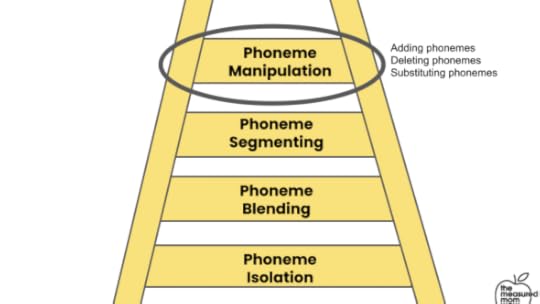 Ladder visual for the levels of phonemic awareness
Ladder visual for the levels of phonemic awareness
The post 5 Important things you may not know about phonological awareness appeared first on The Measured Mom.
January 3, 2021
How to meet every writer’s needs during writing workshop
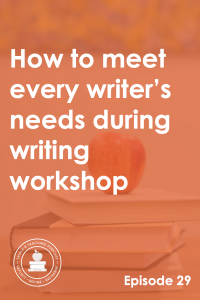
TRT Podcast#29: How to meet every writer’s needs during writing workshop
Writing workshop is the best way to teach writing across the grades. But it’s not without its challenges! How can you meet every writer’s needs?
Learn how to confer with more students (in the limited time that you have)
Discover a quick end-of-the-week routine that will help you stay up-to-date on your writers’ progress
Learn my favorite books and resources that will help you become��an incredible writing teacher
Listen to the episode here
Full episode transcript
Transcript
Download
New Tab
Today's episode marks the end of our eight-week series all about teaching writing. We've talked about what to do about spelling during Writing Workshop, how to help students revise and edit, and what to do when kids won't even get started. We even talked about how to teach writing virtually.
We're finishing off the series today with episode 29, how to meet every writer's needs during Writing Workshop. I'm going to give you five strategies that will help you do just that.
I firmly believe that Writing Workshop is the BEST approach to teach writing in all grade levels from kindergarten and up. Of course, it's not without its challenges and one of those is meeting the needs of every writer. Of course, that's the same challenge we face in everything we teach. How do we help our students who are struggling, our students who are advanced, and our students who are right in the middle all at the SAME time? Today, I'm going to give you five tips for doing that during Writing Workshop.
Number one is conferences. I believe these are the things that could make the biggest difference in your Writing Workshop when it comes to meeting every writer's needs. I gave you a whole episode all about how to give strong writing conferences, that was back in episode 7. Then in our last episode, episode 28, we talked about how to keep the rest of the class writing while you're conferring. So just a quick recap, writing conferences are when you meet individually with student writers and talk to them about their writing and give them a strategy to work on for next time.
The biggest challenge with writing conferences that I have always faced is keeping them short enough so that you can meet with EVERYONE once a week. In fact, I'm not sure I was ever successful with that! That's why I would encourage you to also do small group conferences. This is when you group a set of students together that is struggling with the same thing or could grow in the same area, and you bring them together at a table. They all bring their writing and you teach them this new strategy. It's sort of like a mini lesson with a small group, and then you have them apply it to their own writing. Because you're meeting with so many students at once, probably three to five, you could take a longer time than for a typical conference. You could spend 15 to 20 minutes with this group so you really have time to digest the strategy and help them try it out in their own writing.
Tip number two to meet every writer's needs is to check their work at the end of the week. It's very easy to get caught up in the workshop and your conferences and not always know where every writer is. And so, a way to keep yourself constantly aware of that, is to think about doing something on Friday. It could be your Friday routine where after Writing Workshop they open up their folder or their notebook to their favorite piece of writing from that week. Hopefully they're dating, they're writing with a date stamp, so they can find something from that week, and they open it up and put it on a pile. They just keep putting them on top of the previous student's pile until you have a big stack of writing to look at.
This does not have to take a lot of your time over the weekend, I think you could do it in half an hour. Just look at every notebook or paper that's facing up. You might also want to go through some other ones in their folder if you think you need a better picture of where they're at. You could give a little feedback with a sticky note, and then you could write notes for yourself about how they're doing. This might also help you see who is in need of a conference next week, or if you notice a group of students that are struggling with the same thing or that are ready for the next step, you could plan a small group conference on a particular topic with those students.
Tip number three is to adjust your curriculum to meet the needs of your students. Many people use a Writing Workshop curriculum that they buy on Teachers Pay Teachers, or maybe they use Lucy Calkins Units of Study. Those curricula are going to have a list of lessons laid out in order, and that can be extremely helpful, especially when you're stuck for what to teach next. But one thing they can't do is know exactly what your students need at any given time. While it is good to use those curricula so you don't miss anything and you keep your students moving as writers, there are times where you're going to have to interrupt the prescribed lessons and teach something extra.
Let's say you're teaching your third graders a unit about personal narrative and all of a sudden you notice they're all using quotation marks, or many of them are, and they're using them incorrectly. Well, take a break and teach a writing mini lesson about the proper use of quotation marks.
Let's say you're teaching kindergarten and the lessons are about using drawing to teach something about your writing, but you're finding that many of the students are just getting stuck and aren't sure even how to begin. Then you're going to want to take a break and do a writing mini lesson about how to get unstuck, or how to find ideas for your writing.
Always try to be in tune with where your students are. You can be in tune by checking the writing at the end of the week that I mentioned in the last tip. By doing that, you'll see where your students are struggling or where they could move forward.
Tip number four is one I wish I had known when I was a teacher, and that is to use sharing time as teaching time.
I have to admit, I did not look forward to sharing time and I skipped it more often than not. To me, sharing time was just show and tell time, which got really long and tedious for the rest of us when students were just reading their writing. I've since learned that sharing time is not show and tell. It can be that, but it is also teaching time.
You don't have to have a student read all four pages of their story. You can have them choose their favorite part and tell why it was their favorite. You can take students who were struggling and then you find something they did really well, even if it was just writing a single word in a kindergarten story. You can highlight that and you can have them share their success during sharing time. That's a way to meet individual needs. Students need to be recognized, they need to be encouraged. Even if their writing is not where everyone else's is at, you can teach your class to celebrate the successes of all your students.
My final quick tip today is to educate yourself. There is so much to learn about teaching writing and there are so many great books out there to teach you.
Here are some of my favorite books about teaching writing. I have always loved any books by Regie Routman and Lucy Calkins. Warning: Lucy Calkins tends to be long-winded and her books are usually long. If you want something a little more concise check out Regie Routman, like her book "Writing Essentials". It's an old one, but it's a good one. Some other books if you're teaching very young writers are the books "Talking, Drawing, Writing" by Martha Horn and Mary Ellen Giacobbe. This is a really good book because the authors take children where they are and lead them into the world of writing through drawing. The best part of this book is that it contains a bunch of easy to follow lessons.
Another really good book for young writers is called "Already Ready" by Katie Wood Ray and Matt Glover. There's another book that Katie Wood Ray has written, it's called "About the Authors". That's a good one. If you're teaching first grade, you should read the book, "...And With a Light Touch" by Carol Avery. She talks a lot in there about teaching writing to young kids.
If you want to get better at writing conferences, you'll really love Carl Anderson's book, "How's It Going?" It's not super long, and it is super practical! A really good book with lots of lessons in it is called "No More 'I'm Done!'" By Jennifer Jacobson. It has lots of ways to help students be independent writers. I believe she's also written a book for slightly older writers with other good ideas.
There are many, many books about teaching writing that I love! I'm going to link to a blog post I have on my favorite books about teaching writing.
If you really want to dive deep into how to teach writing with a practical guide and 200 lessons that you can use in K-2, I recommend my online course Teaching Every Writer. As I record this in January of 2021, the course is open for enrollment. In the future, we will close it between sessions. So now is a really good chance to get in if you want to improve the way that you teach writing in 2021. You can learn more about that course at teachingeverywriter.com.
Let's go ahead and sum up the tips we talked about in today's episode, how to meet every writer's needs during Writing Workshop.
Number one is to do conferences. If it's hard for you to squeeze enough in, you can certainly also do small group conferences and meet with more students at one time.
Number two is to check student writing at the end of the week. Have them open their notebook or their folder to their latest piece, or their favorite piece from the week, and put them in a big stack. Then you just check each piece of writing over the weekend making notes about workshop mini lesson changes you want to make or conferences that you want to have.
That brings us to tip number three, which is to adjust your curriculum to meet current needs. It's extremely helpful to have a step-by-step Writing Workshop curriculum, but it's also good not to be completely tied to it. Whenever you notice that your students need review of something or to learn a different strategy, take a break from your curriculum and insert a different lesson.
Number four is to use sharing time as teaching time. It's not just show and tell, it's a chance to highlight individual students and teach students something using their peers' writing.
And finally, number five, educate yourself about what it means to be an excellent teacher of writing. I've linked my favorite books about writing in the show notes, and I also recommend that you join us in our online course, Teaching Every Writer.
This concludes our series about teaching writing, but there's much more on the blog. You can find links to other posts about teaching writing in the show notes for this episode. You can find the show notes at themeasuredmom.com/episode29. Thanks so much for listening and I'll talk to you again next week.
Scroll back to top
Sign up to receive email updates
Enter your name and email address below and I'll send you periodic updates about the podcast.
powered by
Related episodes
Episode 7: 5 secrets to strong writing conferences
Episode 28: How to keep the rest of the class writing while you confer
Recommended books about teaching writing
Blog post with my favorite books
My writing workshop guide (easy to use and reference!)
Other blog posts
What K-2 writers need to know
Mistakes to avoid when teaching writing
The post How to meet every writer’s needs during writing workshop appeared first on The Measured Mom.
It’s a giveaway!

Can you believe it? The Measured Mom is celebrating 8 years!
We’re celebrating by giving eight people a full year’s membership in The Measured Mom Plus …
The Measured Mom Plus is our membership site for Pre-K to third grade educators.
Save time with our engaging, easy-to-use printables.
Get no-print resources that you can use in Google Slides on a desktop, laptop, or tablet.
Enjoy an ads-free experience and one-click access to each printable.
Reclaim your enthusiasm for teaching with our practical mini-courses and video trainings.
When you join you will receive …
ONE-CLICK PRINTABLE LIBRARY
Look forward to��new PreK-Grade 3 math and literacy activities��every month.
Get immediate access to��hundreds of engaging student printables.
Browse the library and download any freebies from the main site��with a single click��(no ads!)
QUICK WORKSHOPS & MINI-COURSES
Get access to��on-demand video workshops and mini-courses��that you can watch 24/7.Our short, practical trainings will��equip you to improve your teaching��immediately.
Look forward to new trainings every other month.
Print��a certificate of completion��when you complete a training.
NO-PRINT RESOURCES
Get digital resources that you can use in Google Slides or Seesaw on a desktop, latop, or tablet.
All of these no-print resources are available for purchase��in The Measured Mom shop, but members get them for free!
Expect new no-print resources every month.
SPECIAL MEMBER SAVINGS
Save at least 33% on all products from The Measured Mom��Shop.��You’ll even get some for free!
WATCH THE VIDEO FOR A PEEK INSIDE …
Learn more about membership here
Enter the giveaway …
The post It’s a giveaway! appeared first on The Measured Mom.
December 20, 2020
Christmas problem solving activity
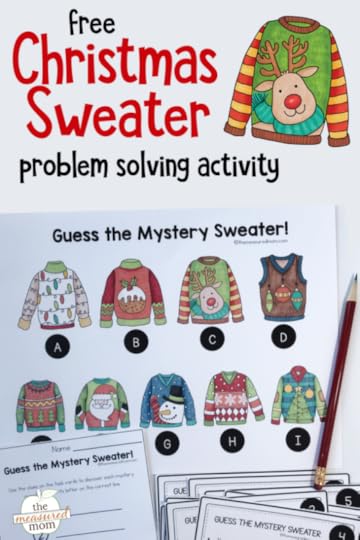
I have a problem.
I’m a clip art addict.
Sometimes I buy clip art without any idea what I’m going to create … because it’s Just. So. Perfect.
That’s how I felt about this Christmas sweater clip art. How could I resist?
Thankfully, I thought of the perfect use for these adorable sweaters … problem solving!
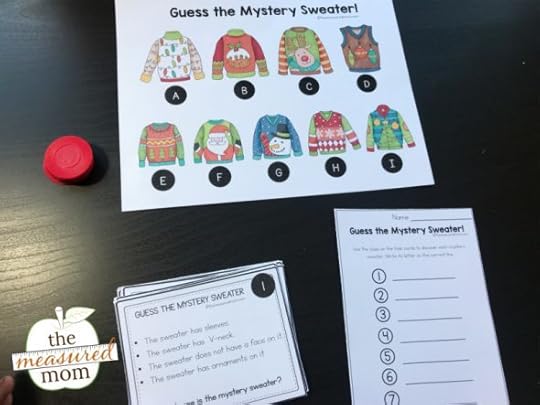
I created a set of task cards. Each card has a set of clues to help kids determine the mystery sweater.
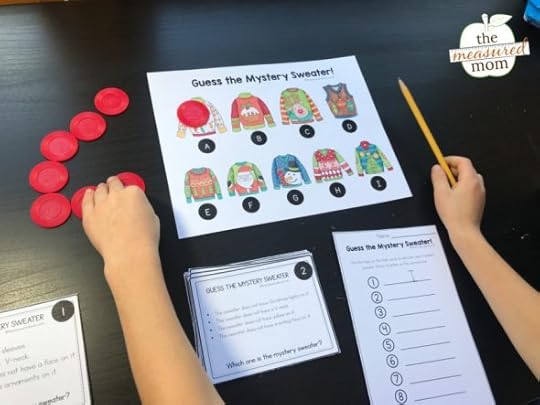
As soon as my Six saw it, he was excited to play.
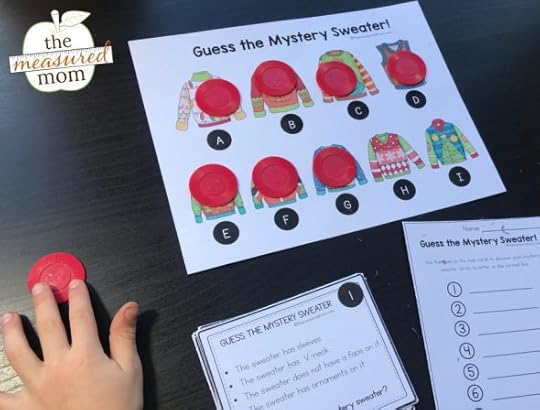
As he read each clue, he covered sweaters that couldn’t be the mystery sweater with a poker chip.
Examples of clues:
The sweater has a V-neck.
The sweater does not have polka dots.
The front of the sweater has something you can hang on a tree.
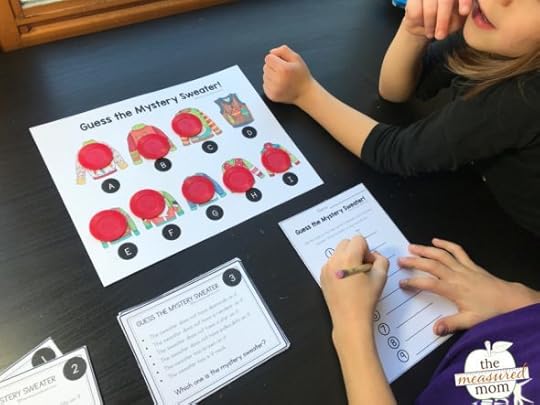
By the last clue, he had narrowed down the possibilities until he knew which was the mystery sweater. He wrote its letter on his recording sheet.
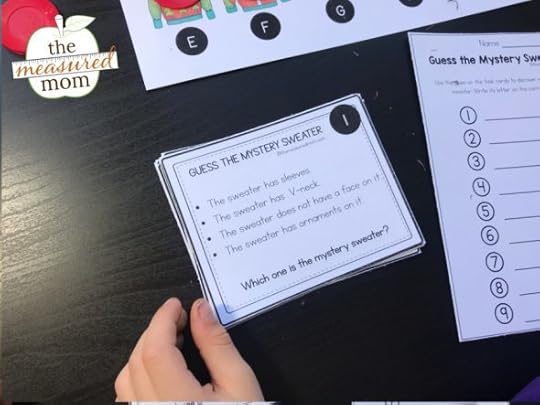
As he did the activity, I realized that the activity reinforces quite a few skills:
Basic reading skills
Close reading skills (detail is important here!)
Basic logic
Problem solving
It surprised me when my son didn’t always cover the correct sweaters. For example, with a clue like this one: The sweater does not have a face on it, he should cover the sweaters with faces because none of them can be the mystery sweater.
Instead, he left those sweaters uncovered and covered all the rest.
Since I was right there with him, I showed him how to read the cards more carefully and figure out which sweaters to eliminate.
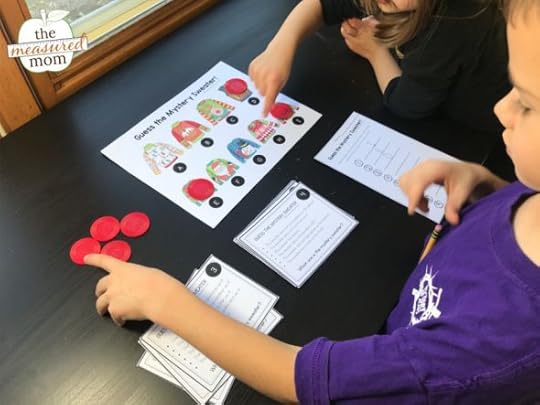
I designed the activity for fluent readers in grades 1-2, but on reflection I think third graders could use it too.
As you can see in the above picture, my Four was thoroughly engaged. She wants to do the activity as well; she’ll just need me to read the clues to her.
I hope your learners enjoy this festive problem solving activity!
P.S. If you like this printable, you need the bundle of 50 mystery problem solving activities!
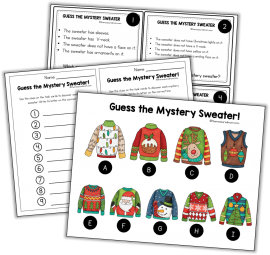
Get your free problem solving activity!
CLICK TO DOWNLOAD
IF YOU LIKE THIS ACTIVITY, YOU’LL LOVE THE BUNDLE!
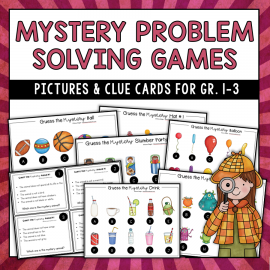
Mystery problem solving activities
$20.00
Build critical thinking skills with 50 engaging mystery problem solving activities! Just print each picture mat and clue cards. Students will read the clues and discovery the mystery character or object.
Buy Now
The post Christmas problem solving activity appeared first on The Measured Mom.
December 19, 2020
40+ free printable Christmas games for kids
Today I’m sharing over forty free printable Christmas games!
Are you in charge of a classroom Christmas party this year? ��Maybe you’re looking for something to entertain the kids during a family Christmas gathering. ��Either way, I’ve got you covered!
Today I’m sharing over forty free and fabulous Christmas printable games for kids.
Christmas��Matching Games
Get�� Christmas matching game from Kids Activities Blog
Crazy Little Projects has another��cute and simple matching game.
Sisters Suitcase has a beautiful nativity matching game that your child can color herself.
Christmas Bingo
Gift of Curiosity has ten different playing cards for Christmas Bingo. ��Perfect for preschoolers!
Crazy Little Projects has ten Christmas bingo boards that older kids will enjoy.
Get��10 more bingo cards from Sweet Bella Roos
I really love these classy Christmas bingo cards from The Crafting Chicks.
You’ll find��6 Christmas bingo cards��at��That’s What Che Said.
Need a larger set? ��Get 20 Bingo cards from Blessed Beyond a Doubt.
Wise Owl Factory is also sharing a giant set:��25 Christmas bingo boards for kindergarten.
Looking for a classroom bingo set for older kids? ��A Mom Knows has a set of ten board with Christmas words instead of pictures.
Get��Nativity Bingo from My Joy Filled Life.
You’ll also find��nativity bingo board games��at��Bible Story Printables.
Scavenger Hunts
Get the pictured��Christmas lights scavenger hunt from Not Consumed.
Here’s another��Christmas lights scavenger hunt��– from Kids Activities Blog.
Drive around town with this scavenger hunt from Tater Tots and Jello.
Family Game Night
Childhood 101 has printable Christmas charades��(pictured).
Get more Christmas charades from Confidence Meets Parenting.
Even more��Christmas charades!����(from Shabby Creek Cottage)
One more set of Christmas charades��– from the Joys of Boys
Test your memory of Christmas carols with this game from Moms and Munchkins.
Play this Christmas trivia game from Lil’ Luna.
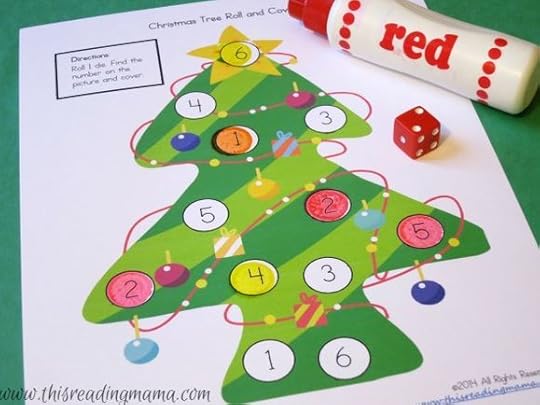
Christmas Math��Games
Get a 24-page pack of Christmas math games from This Reading Mama.
Preschoolers will love these��Christmas grid math games from Gift of Curiosity
Here’s a�� from Toddler Approved
Practice a variety of math skills with this roll a Christmas tree game from 3 Dinosaurs.
Practice multiples with this freebie you can get at TPT.
Seven Thirty Three has this free roll a reindeer game.
��Games for One
Get these mix ‘n match puzzles from Itsy Bitsy Fun.
Get both easy and hard��Christmas crossword puzzles from DLTK.
Try this advanced Christmas word search from Happiness is Homemade.
Here’s a Christmas word scramble from Moms and Munchkins.
Find��6 Christmas word games��at��Classroom Jr.
More Christmas-themed Fun & Learning
I love these��Christmas file folder games from Itsy Bitsy Fun.
Do some��Christmas-themed spelling practice with This Reading Mama.
Make your own die and from Buggy & Buddy.
Practice a variety of skills with Christmas-themed Snakes and Ladders from Itsy Bitsy Fun
Play��Christmas I Spy with��The Pleasantest Thing.
Use these printable photo props from Red Ted Art.
Try these��Christmas Mad Libs from Creative Family Fun.
Make these paper angels from Red Ted Art.
Still have some shopping to do?
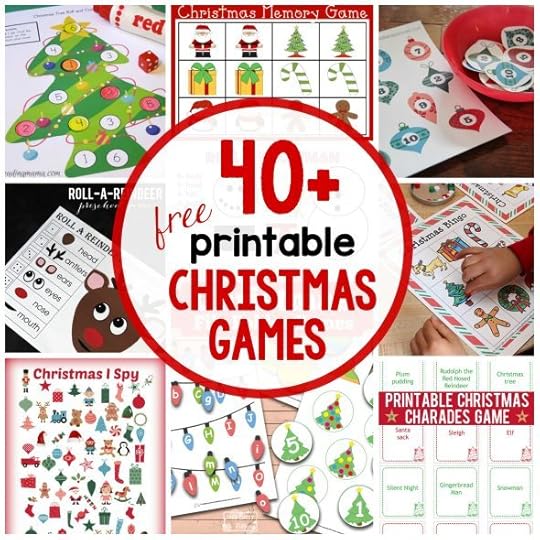
The post 40+ free printable Christmas games for kids appeared first on The Measured Mom.
Anna Geiger's Blog
- Anna Geiger's profile
- 1 follower


